Complementary Feeding Guidelines and Meal Frequency
VerifiedAdded on 2023/01/31
|35
|2477
|27
AI Summary
This document provides guidelines for offering new foods to infants, including holding them upright, introducing small amounts of food per session, and re-introducing refused foods after a week. It also discusses responsive feeding, meal frequency based on age, cutlery and portion sizes, good hygiene and proper food handling, and the development of taste and food preferences. Additionally, it covers the possible reasons for refusal of solids and provides information on adding different foods to a child's diet, emphasizing the importance of iron in complementary feeding.
Contribute Materials
Your contribution can guide someone’s learning journey. Share your
documents today.
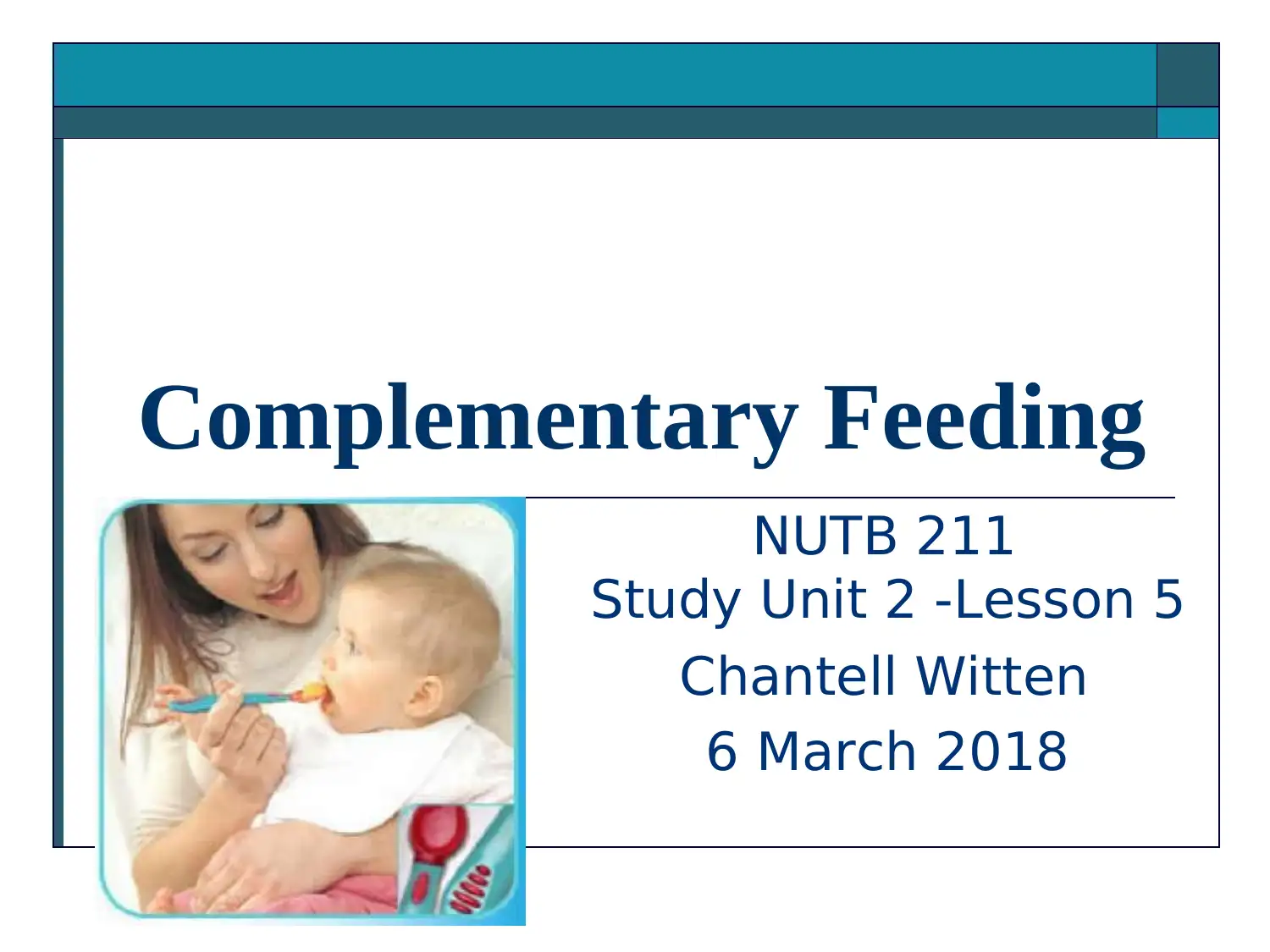
Complementary Feeding
NUTB 211
Study Unit 2 -Lesson 5
Chantell Witten
6 March 2018
NUTB 211
Study Unit 2 -Lesson 5
Chantell Witten
6 March 2018
Secure Best Marks with AI Grader
Need help grading? Try our AI Grader for instant feedback on your assignments.
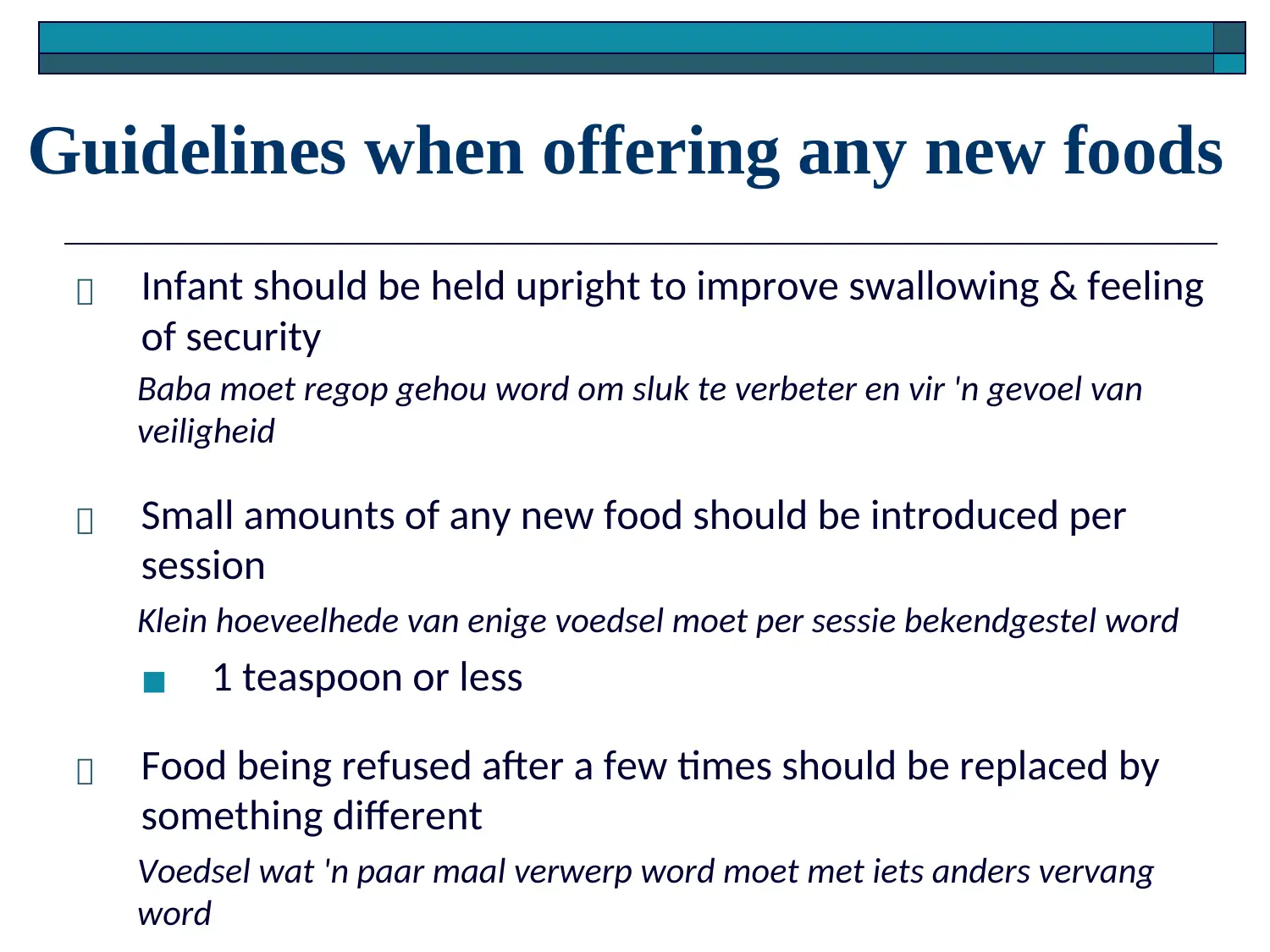
Guidelines when offering any new foods
Infant should be held upright to improve swallowing & feeling
of security
Baba moet regop gehou word om sluk te verbeter en vir 'n gevoel van
veiligheid
Small amounts of any new food should be introduced per
session
Klein hoeveelhede van enige voedsel moet per sessie bekendgestel word
◼ 1 teaspoon or less
Food being refused after a few times should be replaced by
something different
Voedsel wat 'n paar maal verwerp word moet met iets anders vervang
word
Infant should be held upright to improve swallowing & feeling
of security
Baba moet regop gehou word om sluk te verbeter en vir 'n gevoel van
veiligheid
Small amounts of any new food should be introduced per
session
Klein hoeveelhede van enige voedsel moet per sessie bekendgestel word
◼ 1 teaspoon or less
Food being refused after a few times should be replaced by
something different
Voedsel wat 'n paar maal verwerp word moet met iets anders vervang
word
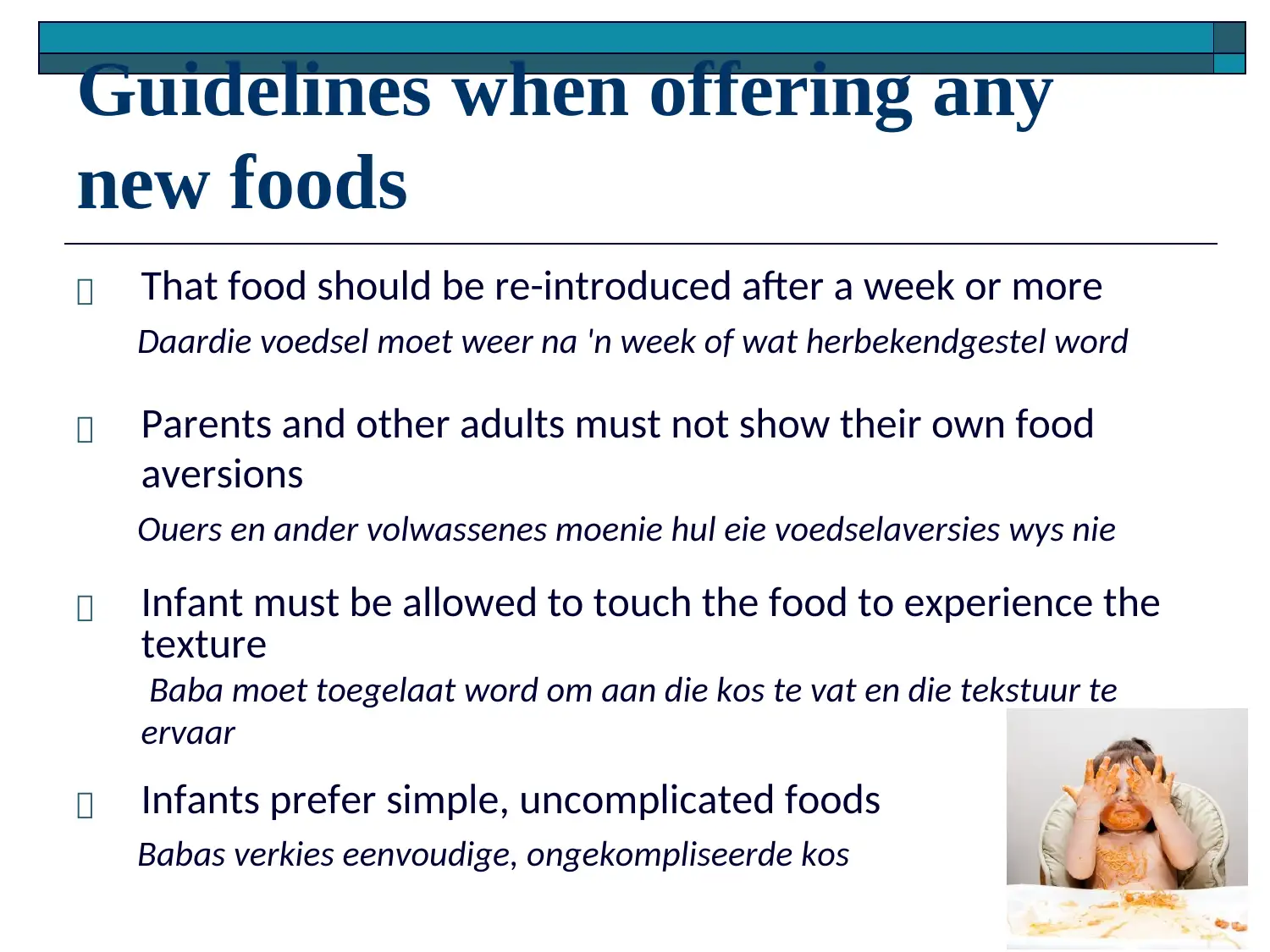
Guidelines when offering any
new foods
That food should be re-introduced after a week or more
Daardie voedsel moet weer na 'n week of wat herbekendgestel word
Parents and other adults must not show their own food
aversions
Ouers en ander volwassenes moenie hul eie voedselaversies wys nie
Infant must be allowed to touch the food to experience the
texture
Baba moet toegelaat word om aan die kos te vat en die tekstuur te
ervaar
Infants prefer simple, uncomplicated foods
Babas verkies eenvoudige, ongekompliseerde kos
new foods
That food should be re-introduced after a week or more
Daardie voedsel moet weer na 'n week of wat herbekendgestel word
Parents and other adults must not show their own food
aversions
Ouers en ander volwassenes moenie hul eie voedselaversies wys nie
Infant must be allowed to touch the food to experience the
texture
Baba moet toegelaat word om aan die kos te vat en die tekstuur te
ervaar
Infants prefer simple, uncomplicated foods
Babas verkies eenvoudige, ongekompliseerde kos
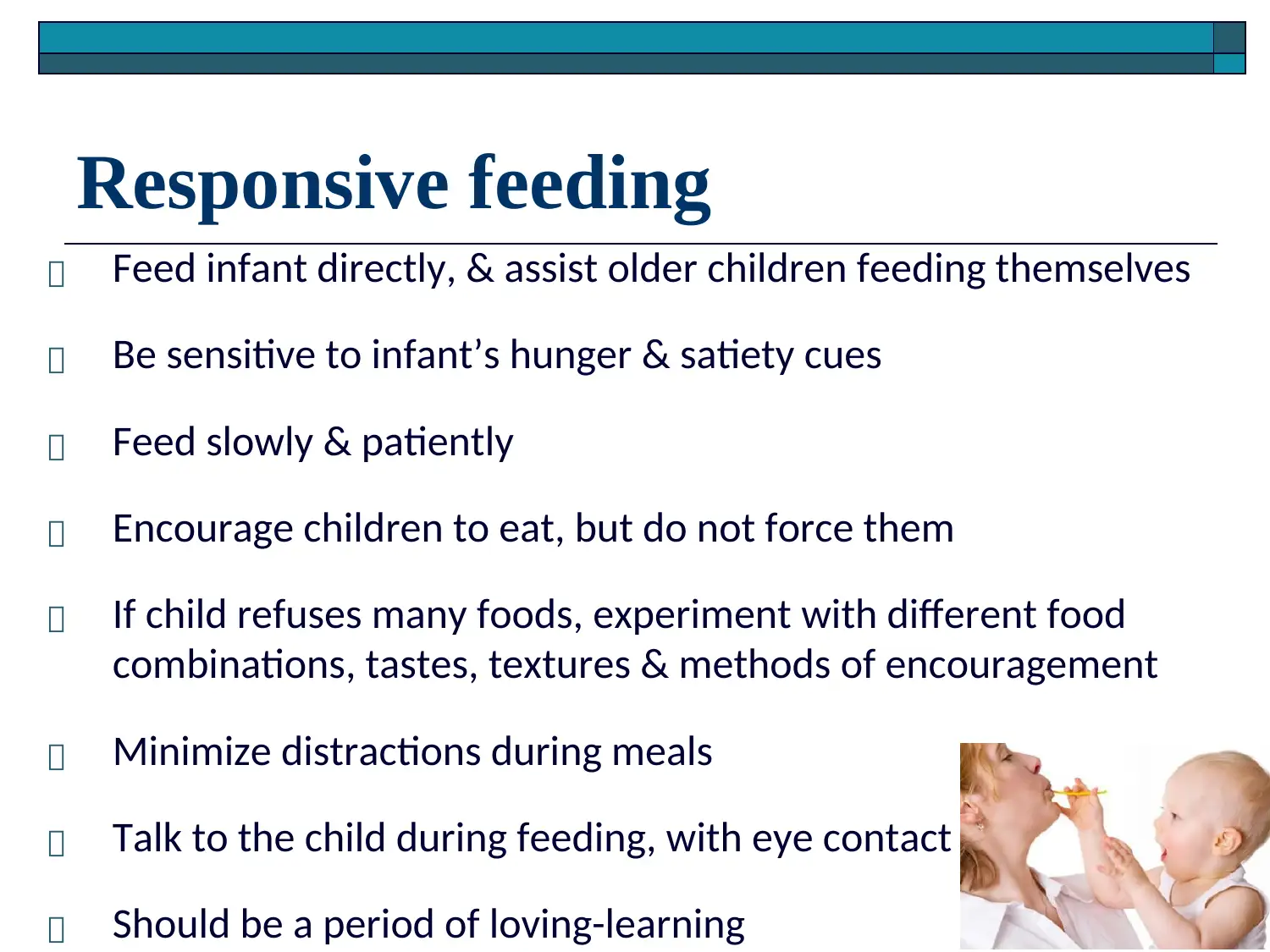
Responsive feeding
Feed infant directly, & assist older children feeding themselves
Be sensitive to infant’s hunger & satiety cues
Feed slowly & patiently
Encourage children to eat, but do not force them
If child refuses many foods, experiment with different food
combinations, tastes, textures & methods of encouragement
Minimize distractions during meals
Talk to the child during feeding, with eye contact
Should be a period of loving-learning
Feed infant directly, & assist older children feeding themselves
Be sensitive to infant’s hunger & satiety cues
Feed slowly & patiently
Encourage children to eat, but do not force them
If child refuses many foods, experiment with different food
combinations, tastes, textures & methods of encouragement
Minimize distractions during meals
Talk to the child during feeding, with eye contact
Should be a period of loving-learning
Secure Best Marks with AI Grader
Need help grading? Try our AI Grader for instant feedback on your assignments.
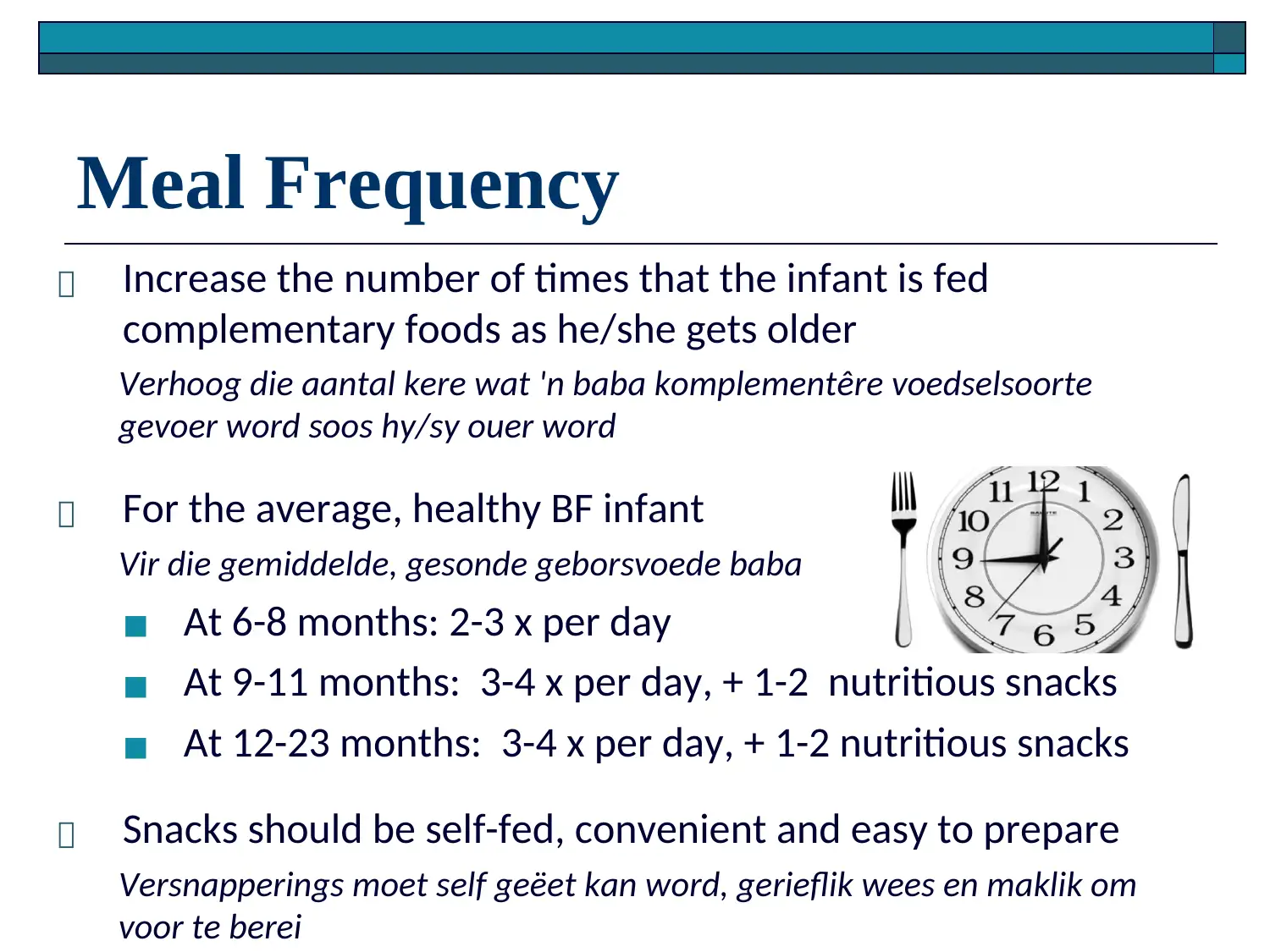
Meal Frequency
Increase the number of times that the infant is fed
complementary foods as he/she gets older
Verhoog die aantal kere wat 'n baba komplementêre voedselsoorte
gevoer word soos hy/sy ouer word
For the average, healthy BF infant
Vir die gemiddelde, gesonde geborsvoede baba
◼ At 6-8 months: 2-3 x per day
◼ At 9-11 months: 3-4 x per day, + 1-2 nutritious snacks
◼ At 12-23 months: 3-4 x per day, + 1-2 nutritious snacks
Snacks should be self-fed, convenient and easy to prepare
Versnapperings moet self geëet kan word, gerieflik wees en maklik om
voor te berei
Increase the number of times that the infant is fed
complementary foods as he/she gets older
Verhoog die aantal kere wat 'n baba komplementêre voedselsoorte
gevoer word soos hy/sy ouer word
For the average, healthy BF infant
Vir die gemiddelde, gesonde geborsvoede baba
◼ At 6-8 months: 2-3 x per day
◼ At 9-11 months: 3-4 x per day, + 1-2 nutritious snacks
◼ At 12-23 months: 3-4 x per day, + 1-2 nutritious snacks
Snacks should be self-fed, convenient and easy to prepare
Versnapperings moet self geëet kan word, gerieflik wees en maklik om
voor te berei
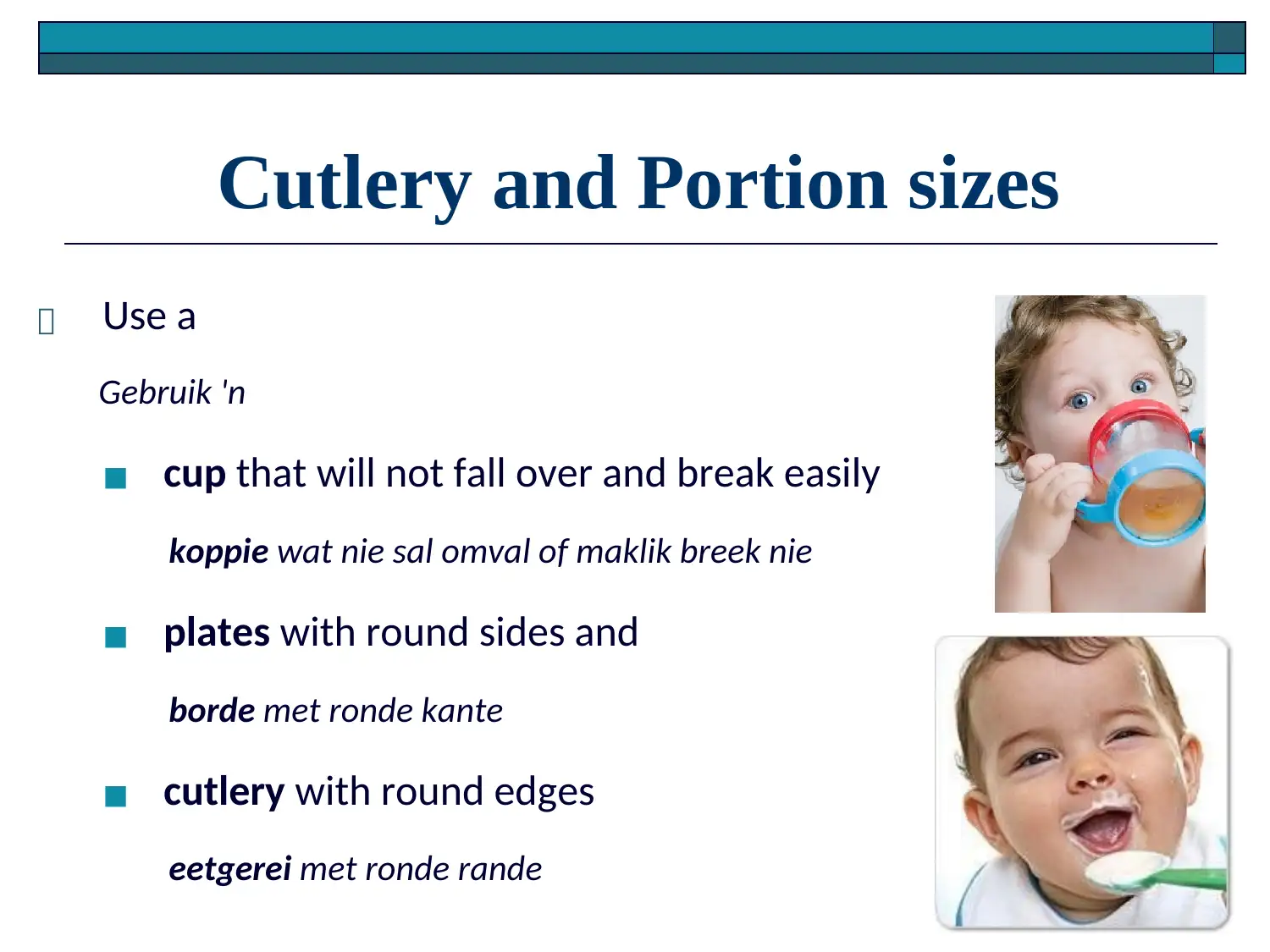
Cutlery and Portion sizes
Use a
Gebruik 'n
◼ cup that will not fall over and break easily
koppie wat nie sal omval of maklik breek nie
◼ plates with round sides and
borde met ronde kante
◼ cutlery with round edges
eetgerei met ronde rande
Use a
Gebruik 'n
◼ cup that will not fall over and break easily
koppie wat nie sal omval of maklik breek nie
◼ plates with round sides and
borde met ronde kante
◼ cutlery with round edges
eetgerei met ronde rande
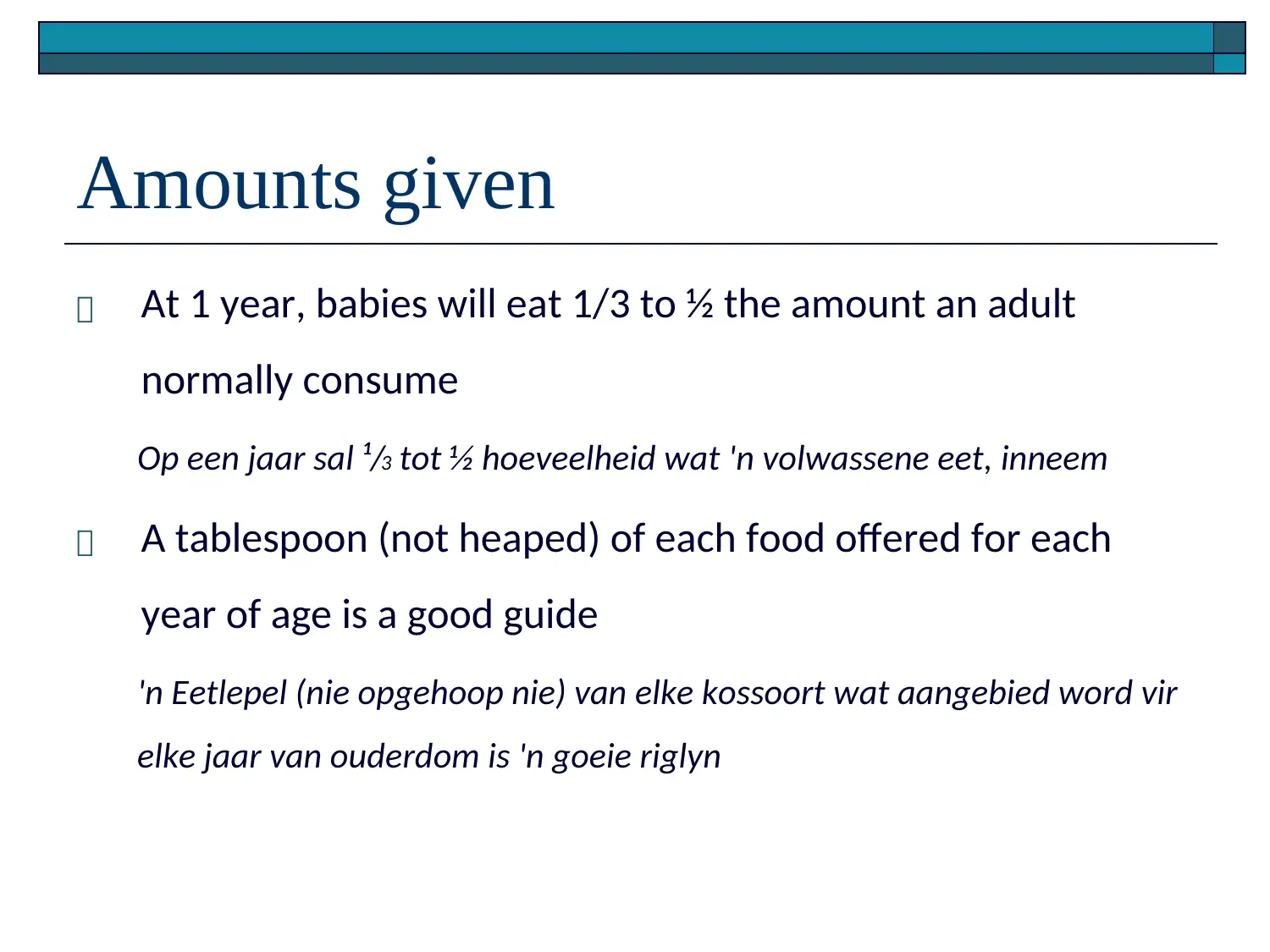
Amounts given
At 1 year, babies will eat 1/3 to ½ the amount an adult
normally consume
Op een jaar sal ¹/3 tot ½ hoeveelheid wat 'n volwassene eet, inneem
A tablespoon (not heaped) of each food offered for each
year of age is a good guide
'n Eetlepel (nie opgehoop nie) van elke kossoort wat aangebied word vir
elke jaar van ouderdom is 'n goeie riglyn
At 1 year, babies will eat 1/3 to ½ the amount an adult
normally consume
Op een jaar sal ¹/3 tot ½ hoeveelheid wat 'n volwassene eet, inneem
A tablespoon (not heaped) of each food offered for each
year of age is a good guide
'n Eetlepel (nie opgehoop nie) van elke kossoort wat aangebied word vir
elke jaar van ouderdom is 'n goeie riglyn
Paraphrase This Document
Need a fresh take? Get an instant paraphrase of this document with our AI Paraphraser
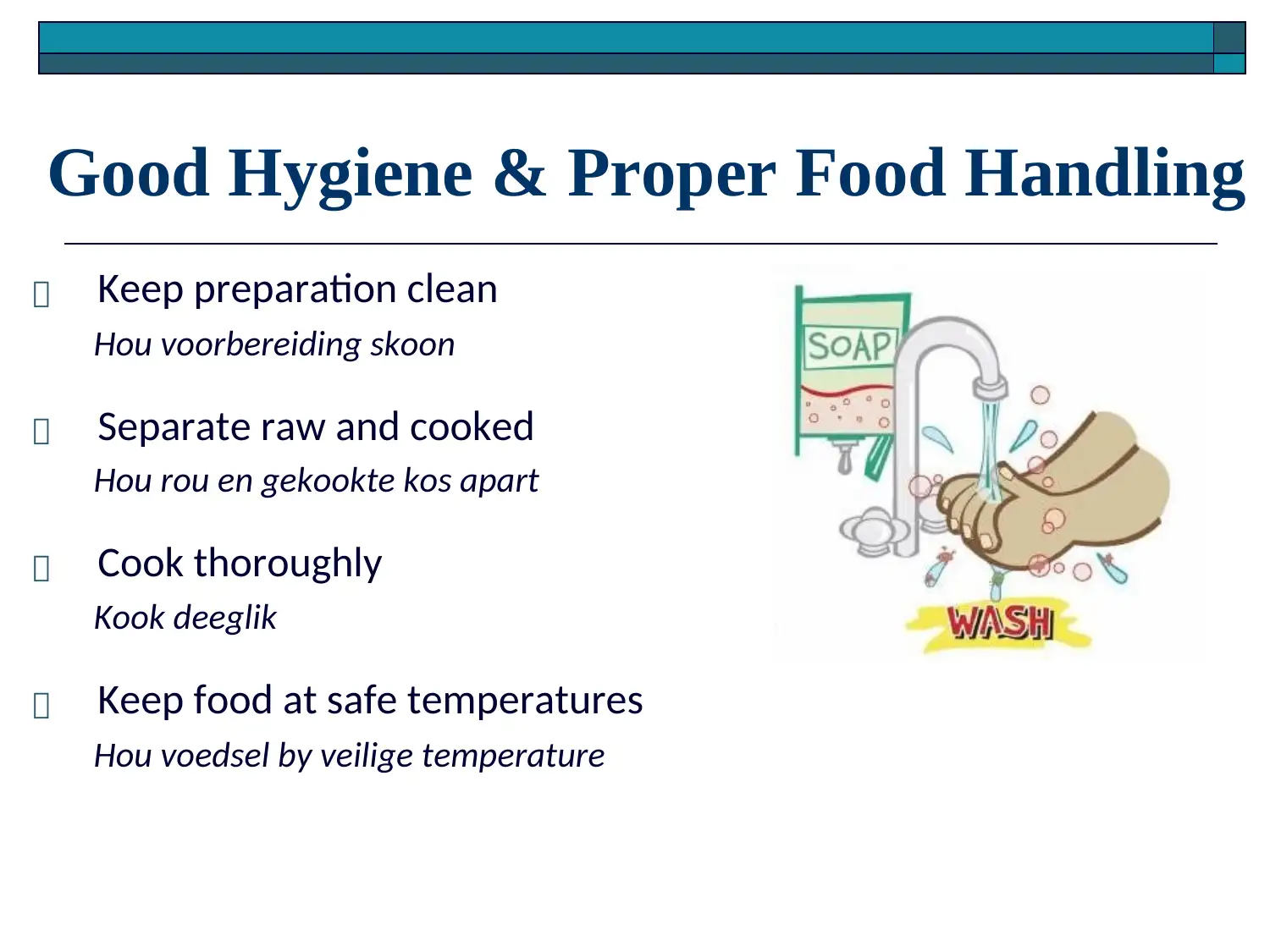
Good Hygiene & Proper Food Handling
Keep preparation clean
Hou voorbereiding skoon
Separate raw and cooked
Hou rou en gekookte kos apart
Cook thoroughly
Kook deeglik
Keep food at safe temperatures
Hou voedsel by veilige temperature
Keep preparation clean
Hou voorbereiding skoon
Separate raw and cooked
Hou rou en gekookte kos apart
Cook thoroughly
Kook deeglik
Keep food at safe temperatures
Hou voedsel by veilige temperature
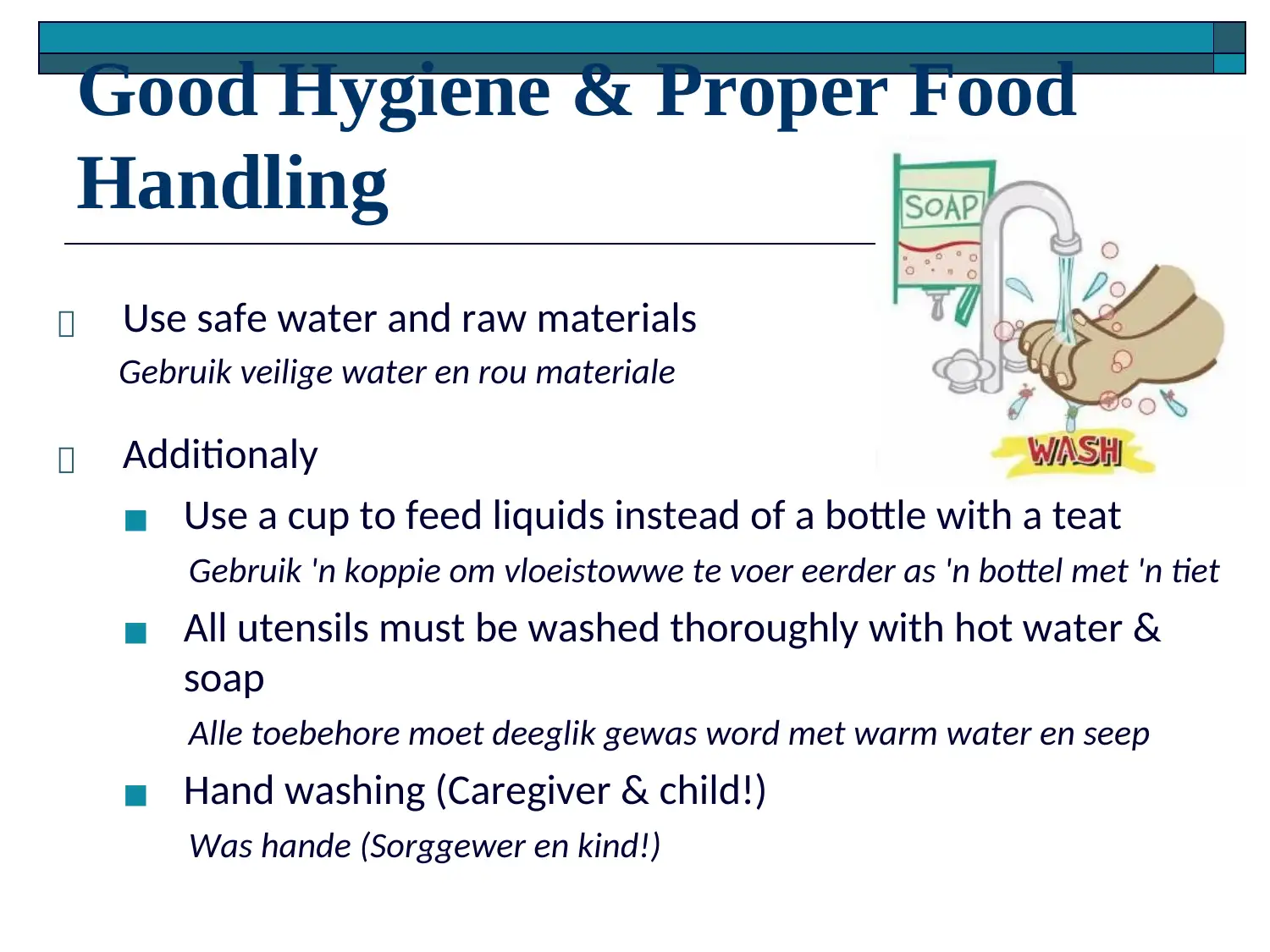
Good Hygiene & Proper Food
Handling
Use safe water and raw materials
Gebruik veilige water en rou materiale
Additionaly
◼ Use a cup to feed liquids instead of a bottle with a teat
Gebruik 'n koppie om vloeistowwe te voer eerder as 'n bottel met 'n tiet
◼ All utensils must be washed thoroughly with hot water &
soap
Alle toebehore moet deeglik gewas word met warm water en seep
◼ Hand washing (Caregiver & child!)
Was hande (Sorggewer en kind!)
Handling
Use safe water and raw materials
Gebruik veilige water en rou materiale
Additionaly
◼ Use a cup to feed liquids instead of a bottle with a teat
Gebruik 'n koppie om vloeistowwe te voer eerder as 'n bottel met 'n tiet
◼ All utensils must be washed thoroughly with hot water &
soap
Alle toebehore moet deeglik gewas word met warm water en seep
◼ Hand washing (Caregiver & child!)
Was hande (Sorggewer en kind!)
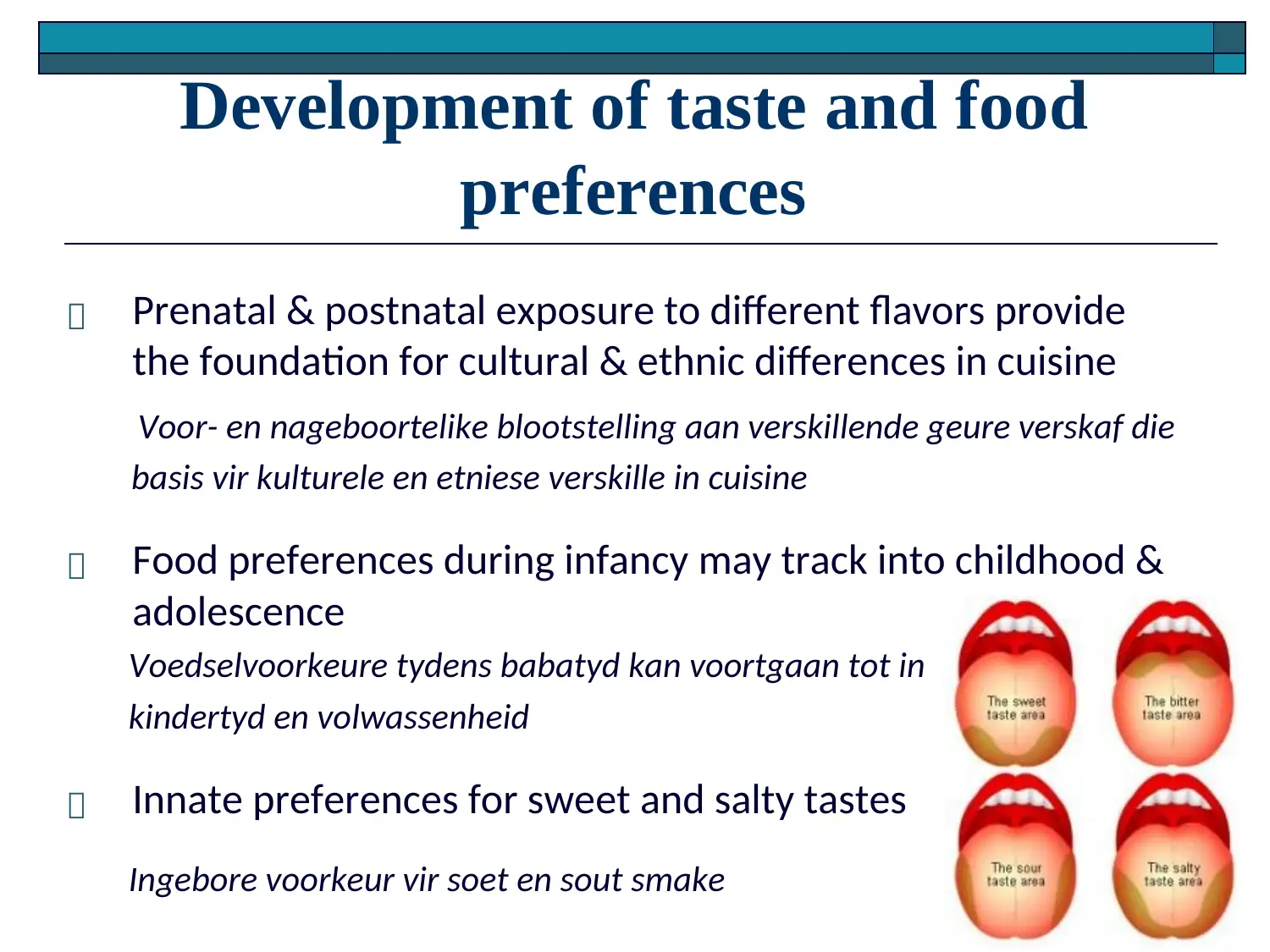
Development of taste and food
preferences
Prenatal & postnatal exposure to different flavors provide
the foundation for cultural & ethnic differences in cuisine
Voor- en nageboortelike blootstelling aan verskillende geure verskaf die
basis vir kulturele en etniese verskille in cuisine
Food preferences during infancy may track into childhood &
adolescence
Voedselvoorkeure tydens babatyd kan voortgaan tot in
kindertyd en volwassenheid
Innate preferences for sweet and salty tastes
Ingebore voorkeur vir soet en sout smake
preferences
Prenatal & postnatal exposure to different flavors provide
the foundation for cultural & ethnic differences in cuisine
Voor- en nageboortelike blootstelling aan verskillende geure verskaf die
basis vir kulturele en etniese verskille in cuisine
Food preferences during infancy may track into childhood &
adolescence
Voedselvoorkeure tydens babatyd kan voortgaan tot in
kindertyd en volwassenheid
Innate preferences for sweet and salty tastes
Ingebore voorkeur vir soet en sout smake
Secure Best Marks with AI Grader
Need help grading? Try our AI Grader for instant feedback on your assignments.
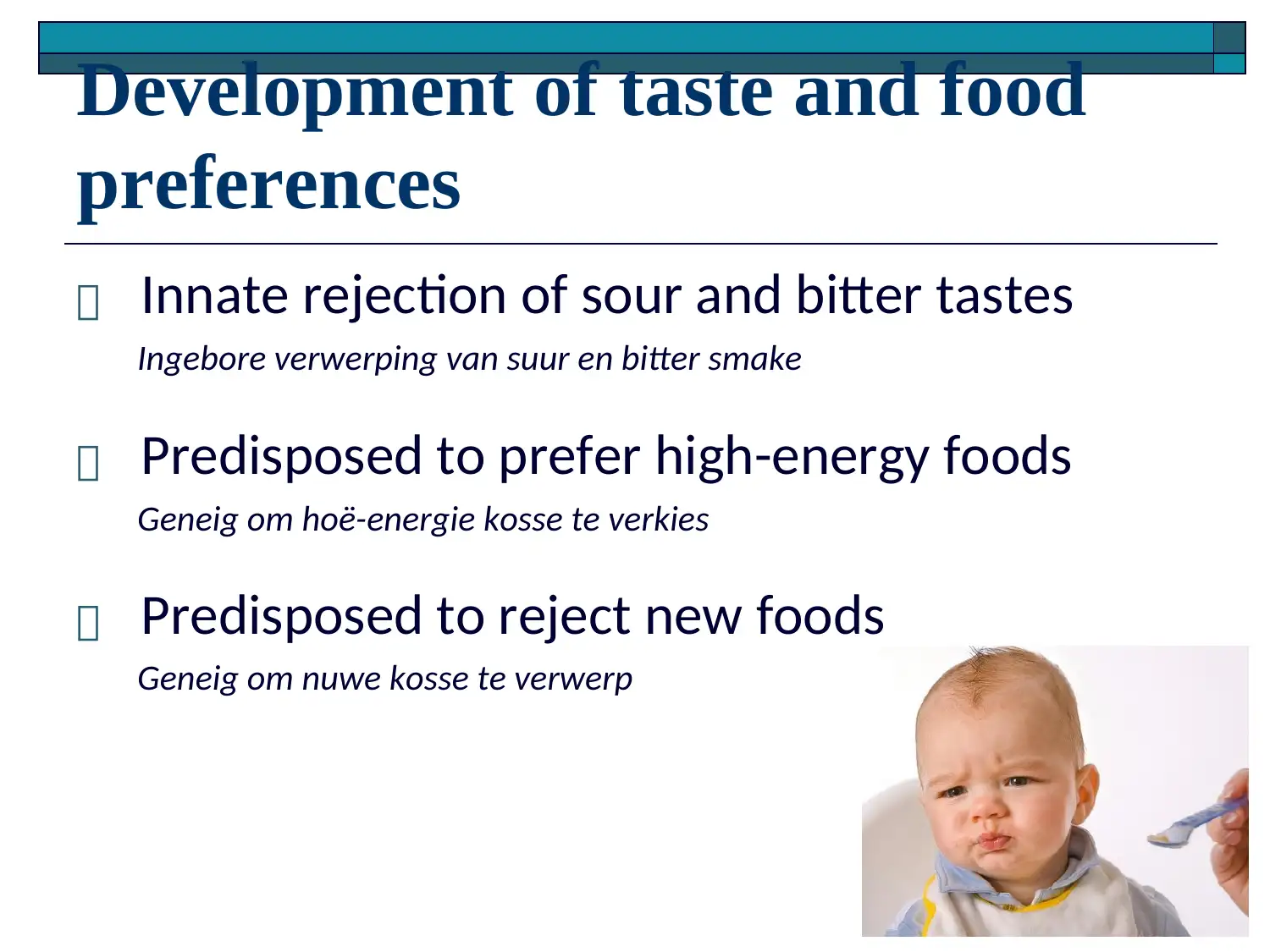
Development of taste and food
preferences
Innate rejection of sour and bitter tastes
Ingebore verwerping van suur en bitter smake
Predisposed to prefer high-energy foods
Geneig om hoë-energie kosse te verkies
Predisposed to reject new foods
Geneig om nuwe kosse te verwerp
preferences
Innate rejection of sour and bitter tastes
Ingebore verwerping van suur en bitter smake
Predisposed to prefer high-energy foods
Geneig om hoë-energie kosse te verkies
Predisposed to reject new foods
Geneig om nuwe kosse te verwerp
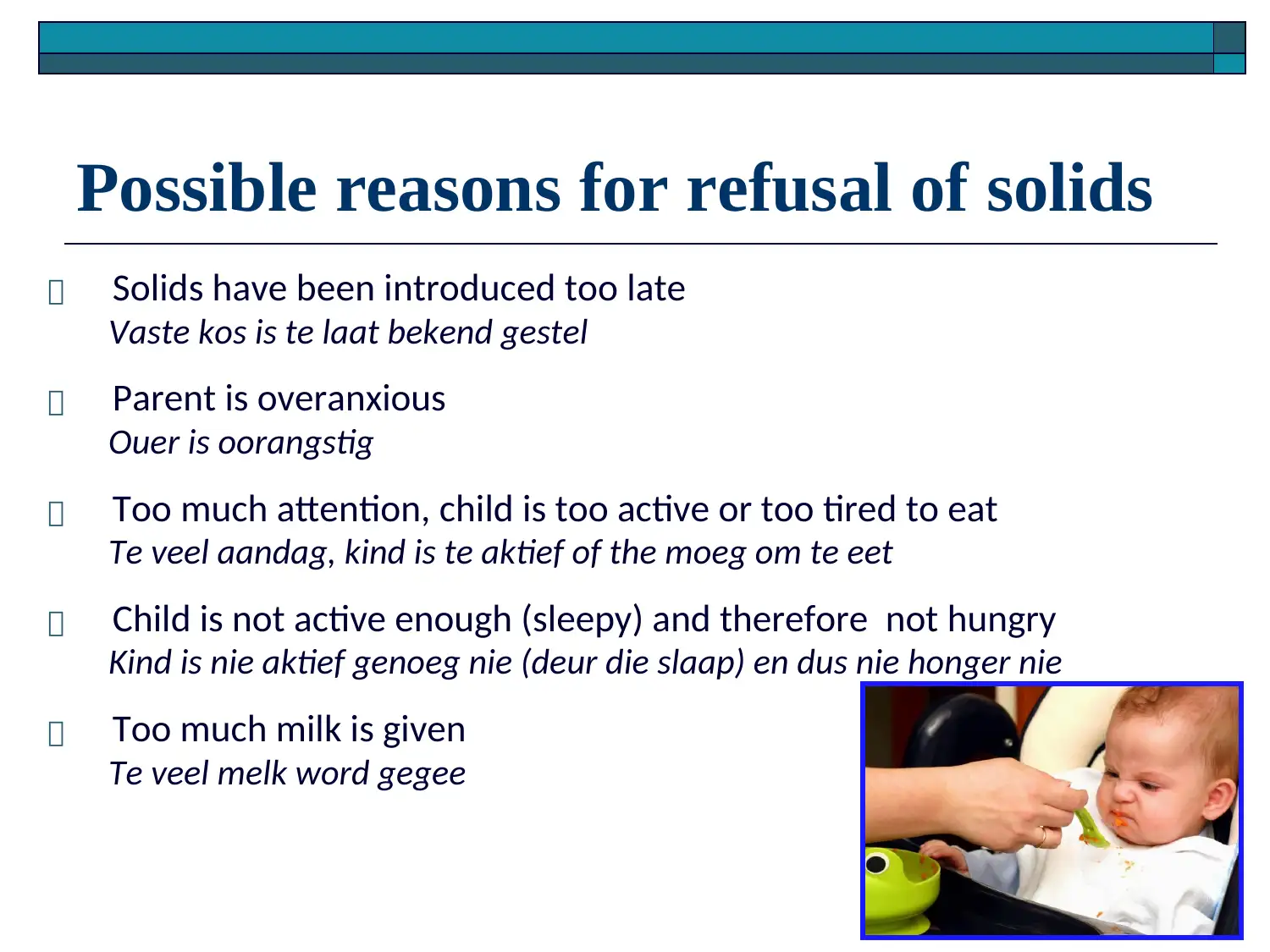
Possible reasons for refusal of solids
Solids have been introduced too late
Vaste kos is te laat bekend gestel
Parent is overanxious
Ouer is oorangstig
Too much attention, child is too active or too tired to eat
Te veel aandag, kind is te aktief of the moeg om te eet
Child is not active enough (sleepy) and therefore not hungry
Kind is nie aktief genoeg nie (deur die slaap) en dus nie honger nie
Too much milk is given
Te veel melk word gegee
Solids have been introduced too late
Vaste kos is te laat bekend gestel
Parent is overanxious
Ouer is oorangstig
Too much attention, child is too active or too tired to eat
Te veel aandag, kind is te aktief of the moeg om te eet
Child is not active enough (sleepy) and therefore not hungry
Kind is nie aktief genoeg nie (deur die slaap) en dus nie honger nie
Too much milk is given
Te veel melk word gegee
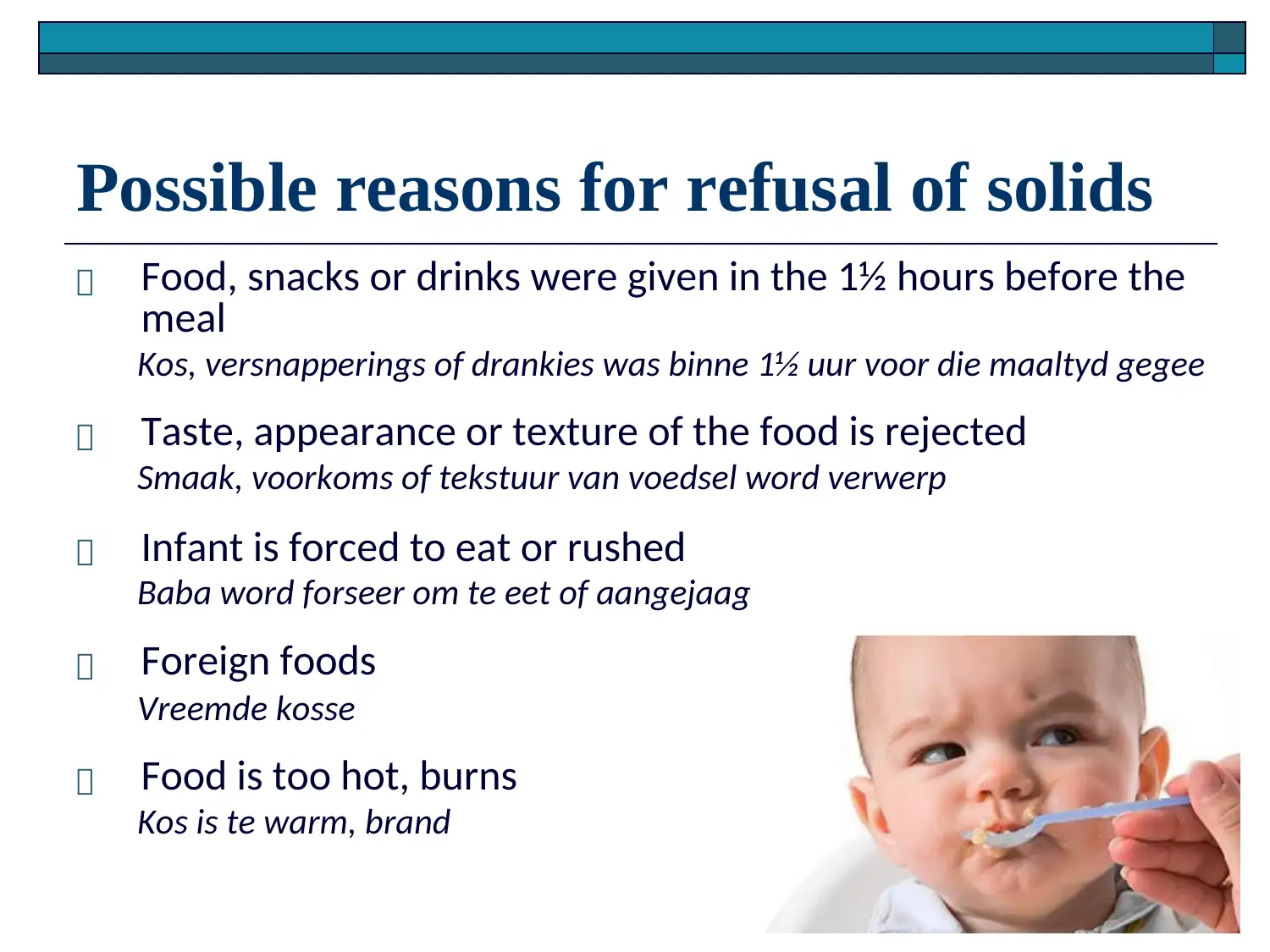
Possible reasons for refusal of solids
Food, snacks or drinks were given in the 1½ hours before the
meal
Kos, versnapperings of drankies was binne 1½ uur voor die maaltyd gegee
Taste, appearance or texture of the food is rejected
Smaak, voorkoms of tekstuur van voedsel word verwerp
Infant is forced to eat or rushed
Baba word forseer om te eet of aangejaag
Foreign foods
Vreemde kosse
Food is too hot, burns
Kos is te warm, brand
Food, snacks or drinks were given in the 1½ hours before the
meal
Kos, versnapperings of drankies was binne 1½ uur voor die maaltyd gegee
Taste, appearance or texture of the food is rejected
Smaak, voorkoms of tekstuur van voedsel word verwerp
Infant is forced to eat or rushed
Baba word forseer om te eet of aangejaag
Foreign foods
Vreemde kosse
Food is too hot, burns
Kos is te warm, brand
Paraphrase This Document
Need a fresh take? Get an instant paraphrase of this document with our AI Paraphraser
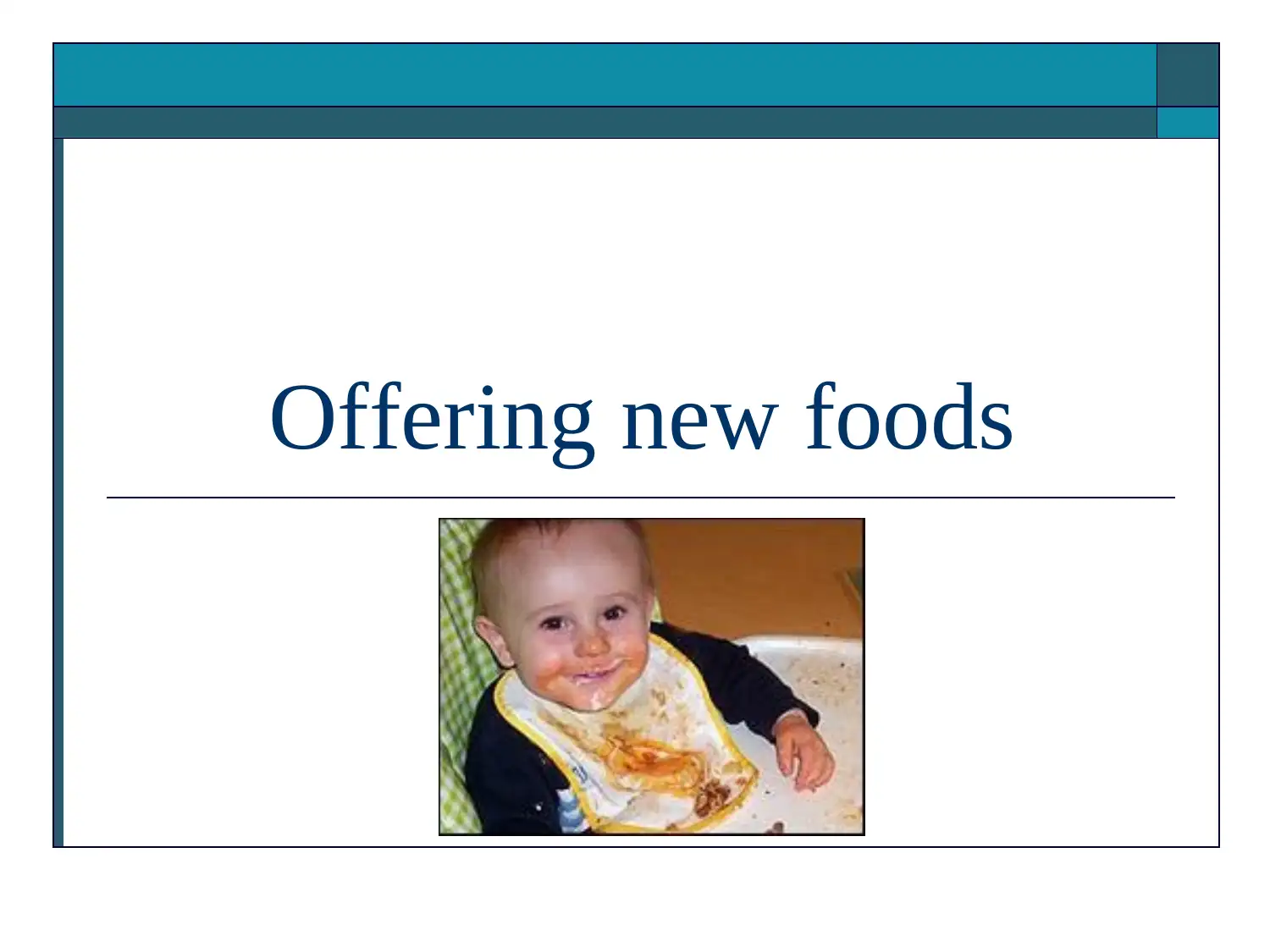
Offering new foods
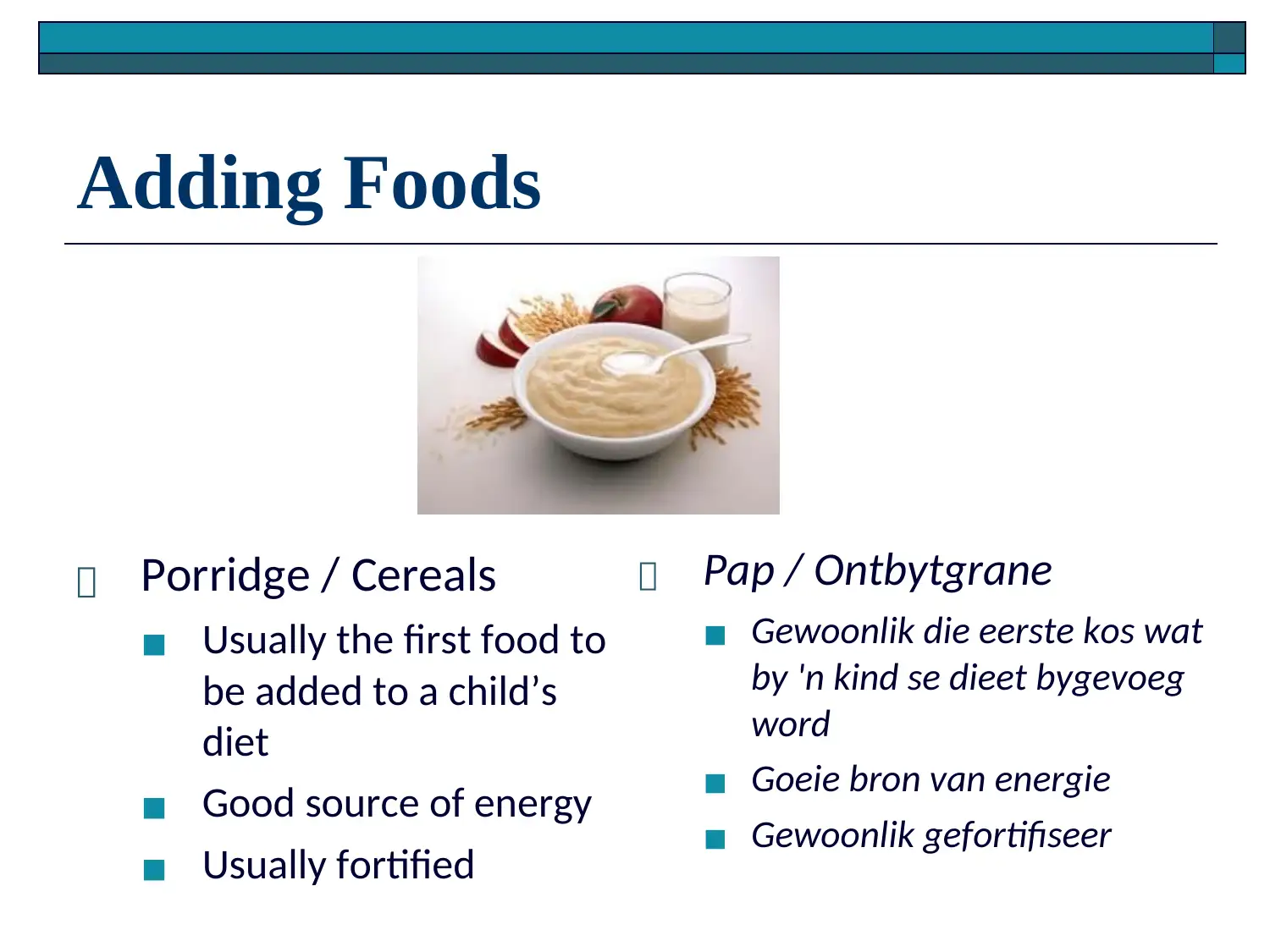
Adding Foods
Porridge / Cereals
◼ Usually the first food to
be added to a child’s
diet
◼ Good source of energy
◼ Usually fortified
Pap / Ontbytgrane
◼ Gewoonlik die eerste kos wat
by 'n kind se dieet bygevoeg
word
◼ Goeie bron van energie
◼ Gewoonlik gefortifiseer
Porridge / Cereals
◼ Usually the first food to
be added to a child’s
diet
◼ Good source of energy
◼ Usually fortified
Pap / Ontbytgrane
◼ Gewoonlik die eerste kos wat
by 'n kind se dieet bygevoeg
word
◼ Goeie bron van energie
◼ Gewoonlik gefortifiseer
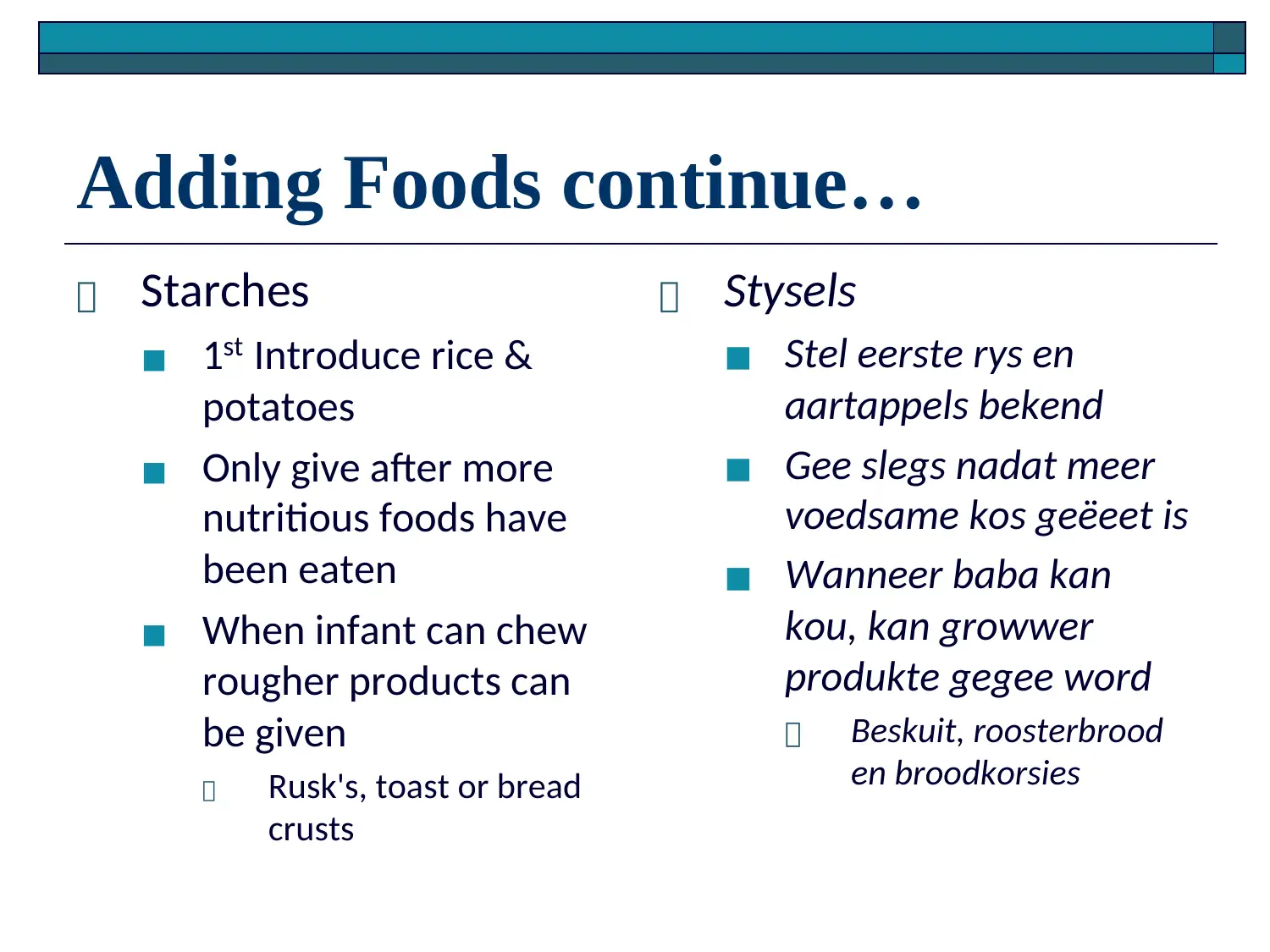
Adding Foods continue…
Starches
◼ 1st Introduce rice &
potatoes
◼ Only give after more
nutritious foods have
been eaten
◼ When infant can chew
rougher products can
be given
Rusk's, toast or bread
crusts
Stysels
◼ Stel eerste rys en
aartappels bekend
◼ Gee slegs nadat meer
voedsame kos geëeet is
◼ Wanneer baba kan
kou, kan growwer
produkte gegee word
Beskuit, roosterbrood
en broodkorsies
Starches
◼ 1st Introduce rice &
potatoes
◼ Only give after more
nutritious foods have
been eaten
◼ When infant can chew
rougher products can
be given
Rusk's, toast or bread
crusts
Stysels
◼ Stel eerste rys en
aartappels bekend
◼ Gee slegs nadat meer
voedsame kos geëeet is
◼ Wanneer baba kan
kou, kan growwer
produkte gegee word
Beskuit, roosterbrood
en broodkorsies
Secure Best Marks with AI Grader
Need help grading? Try our AI Grader for instant feedback on your assignments.
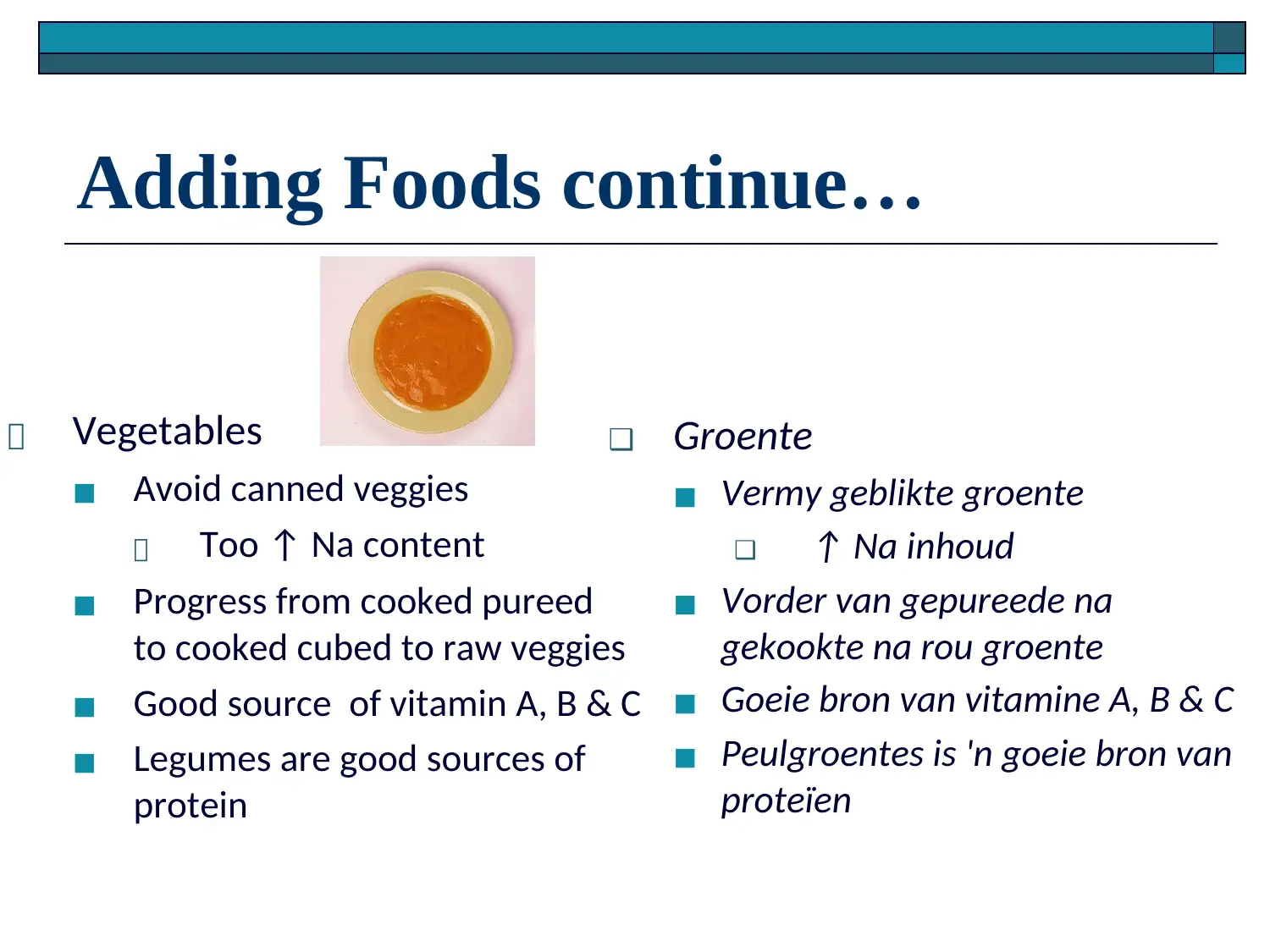
Adding Foods continue…
Vegetables
◼ Avoid canned veggies
Too ↑ Na content
◼ Progress from cooked pureed
to cooked cubed to raw veggies
◼ Good source of vitamin A, B & C
◼ Legumes are good sources of
protein
❑ Groente
◼ Vermy geblikte groente
❑ ↑ Na inhoud
◼ Vorder van gepureede na
gekookte na rou groente
◼ Goeie bron van vitamine A, B & C
◼ Peulgroentes is 'n goeie bron van
proteïen
Vegetables
◼ Avoid canned veggies
Too ↑ Na content
◼ Progress from cooked pureed
to cooked cubed to raw veggies
◼ Good source of vitamin A, B & C
◼ Legumes are good sources of
protein
❑ Groente
◼ Vermy geblikte groente
❑ ↑ Na inhoud
◼ Vorder van gepureede na
gekookte na rou groente
◼ Goeie bron van vitamine A, B & C
◼ Peulgroentes is 'n goeie bron van
proteïen
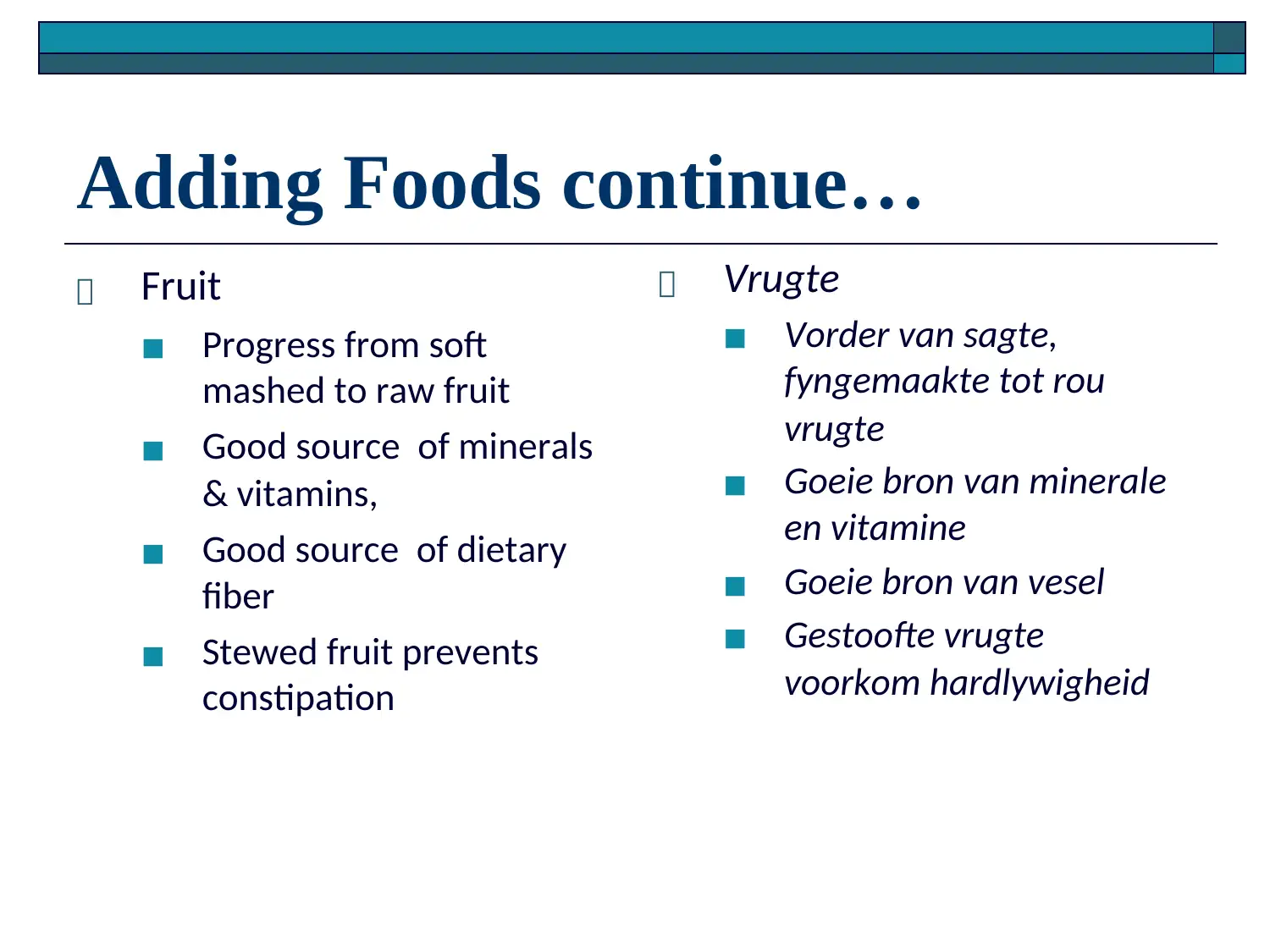
Adding Foods continue…
Fruit
◼ Progress from soft
mashed to raw fruit
◼ Good source of minerals
& vitamins,
◼ Good source of dietary
fiber
◼ Stewed fruit prevents
constipation
Vrugte
◼ Vorder van sagte,
fyngemaakte tot rou
vrugte
◼ Goeie bron van minerale
en vitamine
◼ Goeie bron van vesel
◼ Gestoofte vrugte
voorkom hardlywigheid
Fruit
◼ Progress from soft
mashed to raw fruit
◼ Good source of minerals
& vitamins,
◼ Good source of dietary
fiber
◼ Stewed fruit prevents
constipation
Vrugte
◼ Vorder van sagte,
fyngemaakte tot rou
vrugte
◼ Goeie bron van minerale
en vitamine
◼ Goeie bron van vesel
◼ Gestoofte vrugte
voorkom hardlywigheid
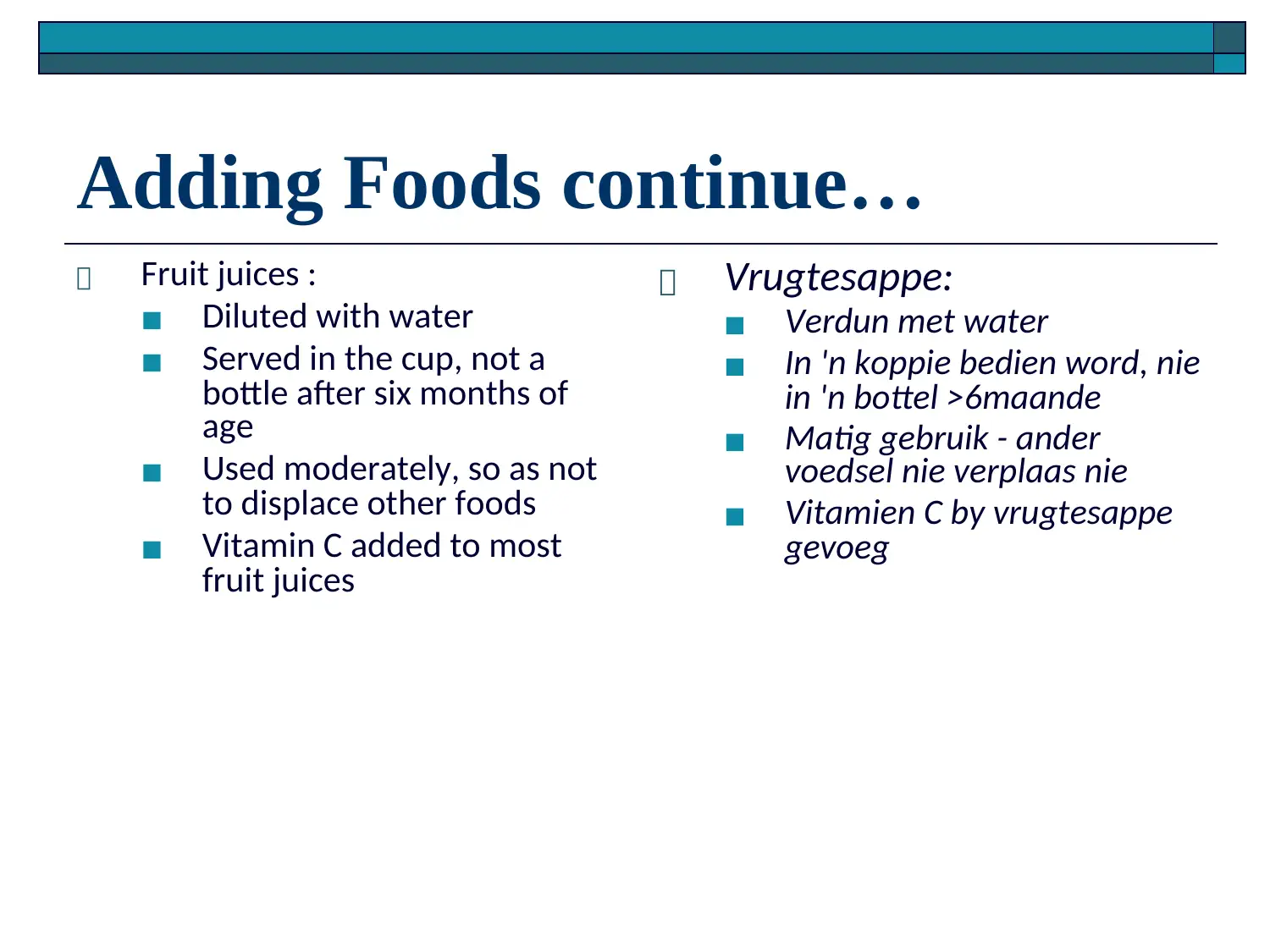
Adding Foods continue…
Fruit juices :
◼ Diluted with water
◼ Served in the cup, not a
bottle after six months of
age
◼ Used moderately, so as not
to displace other foods
◼ Vitamin C added to most
fruit juices
Vrugtesappe:
◼ Verdun met water
◼ In 'n koppie bedien word, nie
in 'n bottel >6maande
◼ Matig gebruik - ander
voedsel nie verplaas nie
◼ Vitamien C by vrugtesappe
gevoeg
Fruit juices :
◼ Diluted with water
◼ Served in the cup, not a
bottle after six months of
age
◼ Used moderately, so as not
to displace other foods
◼ Vitamin C added to most
fruit juices
Vrugtesappe:
◼ Verdun met water
◼ In 'n koppie bedien word, nie
in 'n bottel >6maande
◼ Matig gebruik - ander
voedsel nie verplaas nie
◼ Vitamien C by vrugtesappe
gevoeg
Paraphrase This Document
Need a fresh take? Get an instant paraphrase of this document with our AI Paraphraser
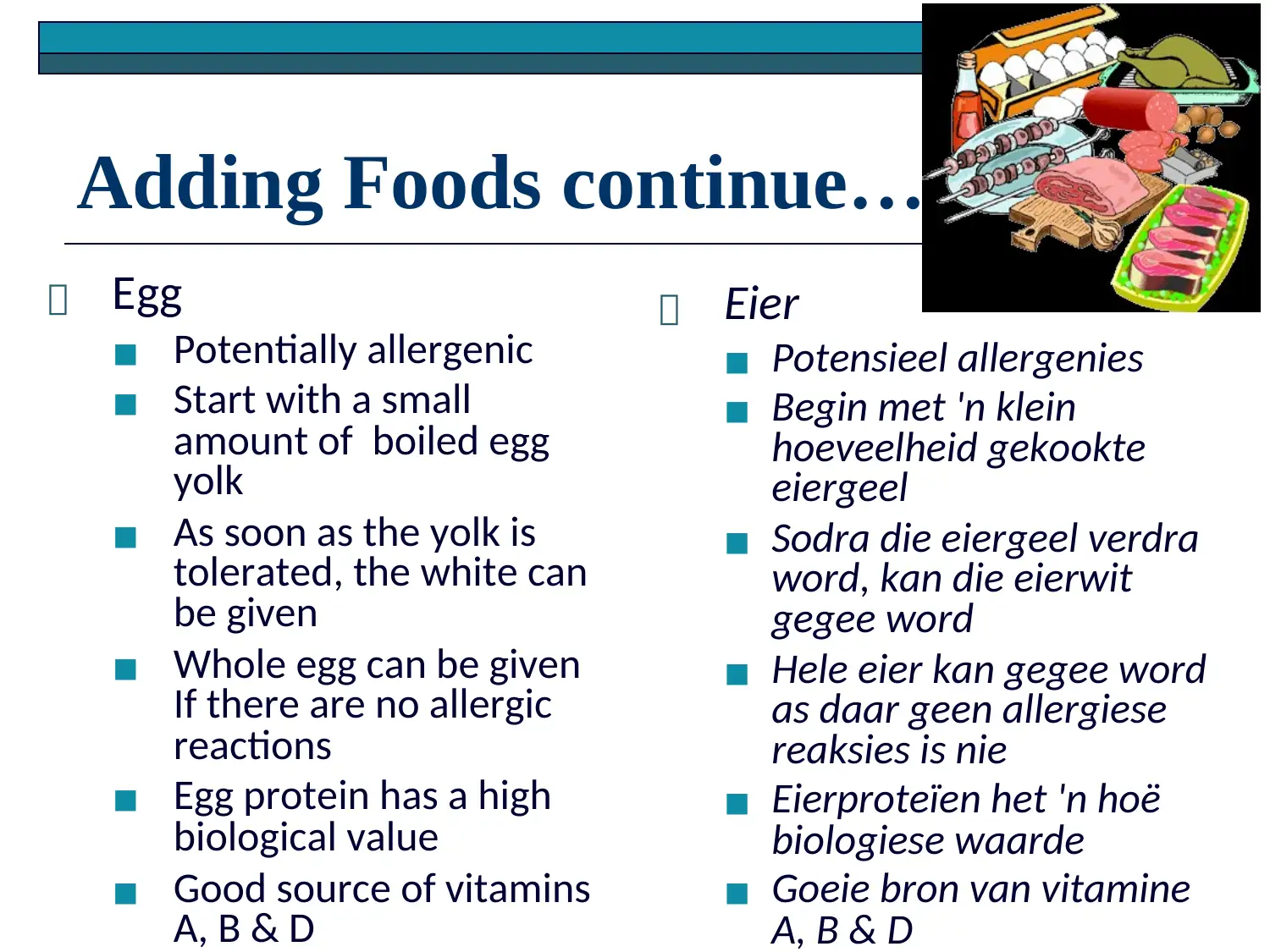
Adding Foods continue…
Egg
◼ Potentially allergenic
◼ Start with a small
amount of boiled egg
yolk
◼ As soon as the yolk is
tolerated, the white can
be given
◼ Whole egg can be given
If there are no allergic
reactions
◼ Egg protein has a high
biological value
◼ Good source of vitamins
A, B & D
Eier
◼ Potensieel allergenies
◼ Begin met 'n klein
hoeveelheid gekookte
eiergeel
◼ Sodra die eiergeel verdra
word, kan die eierwit
gegee word
◼ Hele eier kan gegee word
as daar geen allergiese
reaksies is nie
◼ Eierproteïen het 'n hoë
biologiese waarde
◼ Goeie bron van vitamine
A, B & D
Egg
◼ Potentially allergenic
◼ Start with a small
amount of boiled egg
yolk
◼ As soon as the yolk is
tolerated, the white can
be given
◼ Whole egg can be given
If there are no allergic
reactions
◼ Egg protein has a high
biological value
◼ Good source of vitamins
A, B & D
Eier
◼ Potensieel allergenies
◼ Begin met 'n klein
hoeveelheid gekookte
eiergeel
◼ Sodra die eiergeel verdra
word, kan die eierwit
gegee word
◼ Hele eier kan gegee word
as daar geen allergiese
reaksies is nie
◼ Eierproteïen het 'n hoë
biologiese waarde
◼ Goeie bron van vitamine
A, B & D
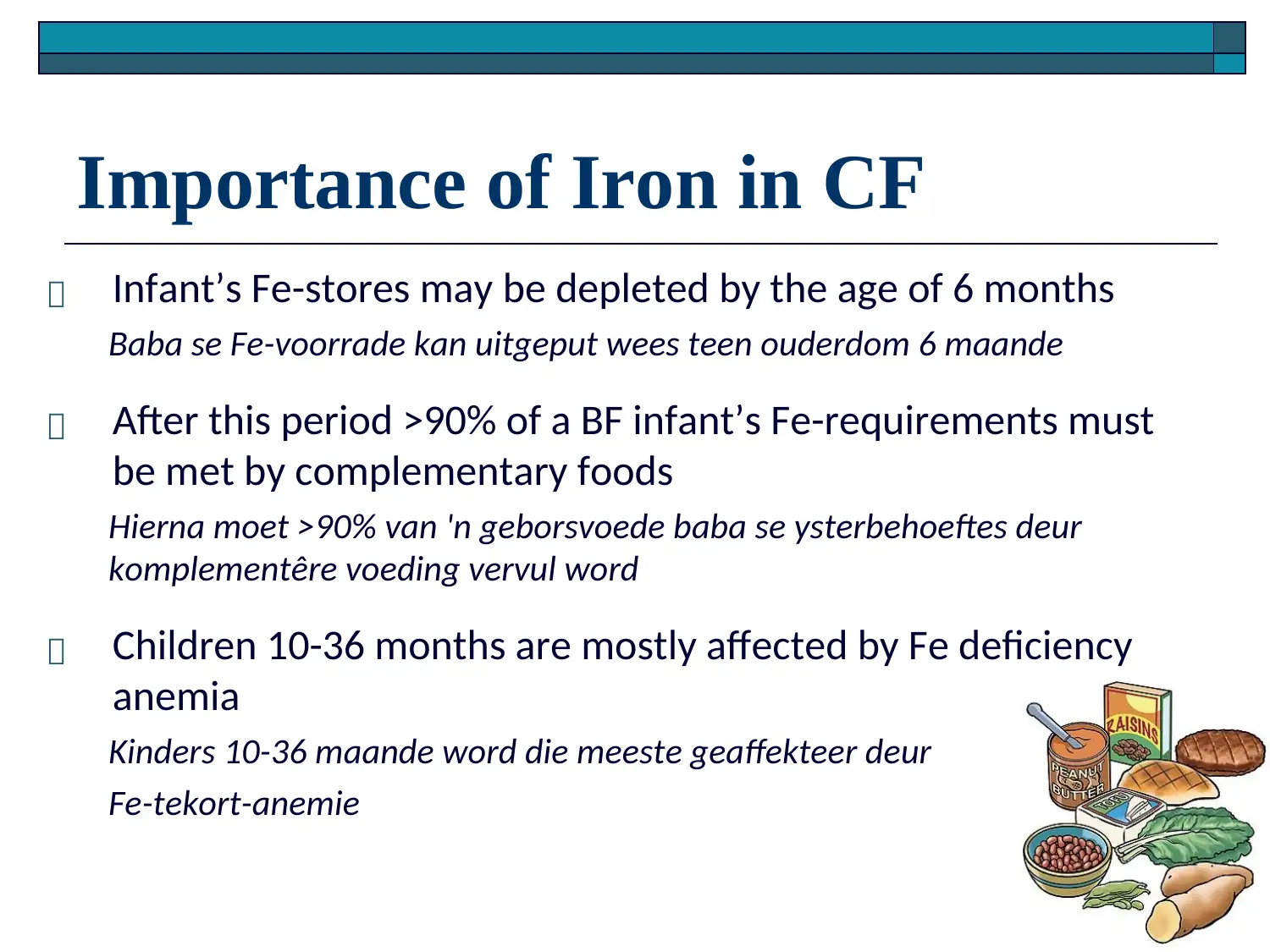
Importance of Iron in CF
Infant’s Fe-stores may be depleted by the age of 6 months
Baba se Fe-voorrade kan uitgeput wees teen ouderdom 6 maande
After this period >90% of a BF infant’s Fe-requirements must
be met by complementary foods
Hierna moet >90% van 'n geborsvoede baba se ysterbehoeftes deur
komplementêre voeding vervul word
Children 10-36 months are mostly affected by Fe deficiency
anemia
Kinders 10-36 maande word die meeste geaffekteer deur
Fe-tekort-anemie
Infant’s Fe-stores may be depleted by the age of 6 months
Baba se Fe-voorrade kan uitgeput wees teen ouderdom 6 maande
After this period >90% of a BF infant’s Fe-requirements must
be met by complementary foods
Hierna moet >90% van 'n geborsvoede baba se ysterbehoeftes deur
komplementêre voeding vervul word
Children 10-36 months are mostly affected by Fe deficiency
anemia
Kinders 10-36 maande word die meeste geaffekteer deur
Fe-tekort-anemie
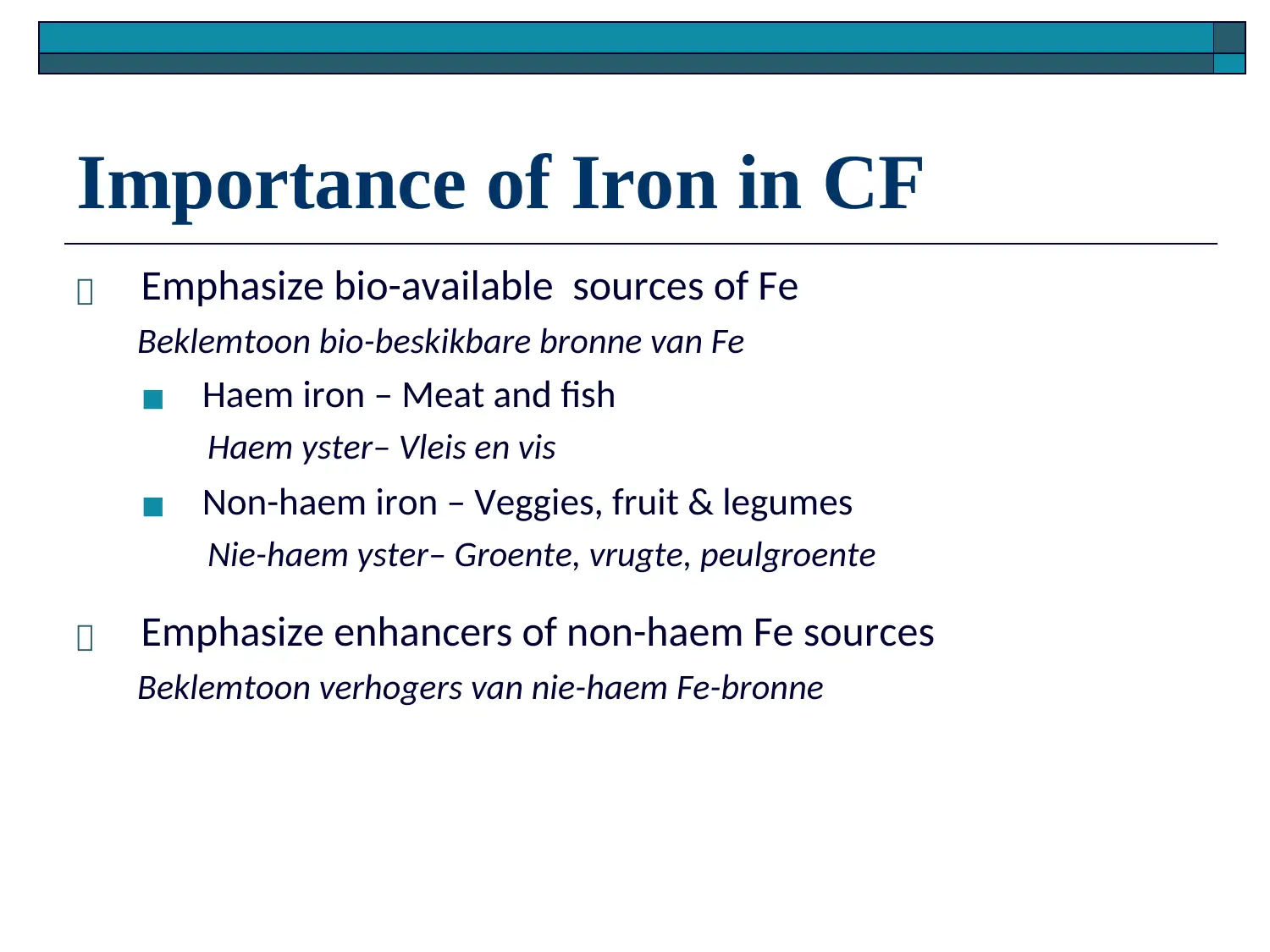
Importance of Iron in CF
Emphasize bio-available sources of Fe
Beklemtoon bio-beskikbare bronne van Fe
◼ Haem iron – Meat and fish
Haem yster– Vleis en vis
◼ Non-haem iron – Veggies, fruit & legumes
Nie-haem yster– Groente, vrugte, peulgroente
Emphasize enhancers of non-haem Fe sources
Beklemtoon verhogers van nie-haem Fe-bronne
Emphasize bio-available sources of Fe
Beklemtoon bio-beskikbare bronne van Fe
◼ Haem iron – Meat and fish
Haem yster– Vleis en vis
◼ Non-haem iron – Veggies, fruit & legumes
Nie-haem yster– Groente, vrugte, peulgroente
Emphasize enhancers of non-haem Fe sources
Beklemtoon verhogers van nie-haem Fe-bronne
Secure Best Marks with AI Grader
Need help grading? Try our AI Grader for instant feedback on your assignments.
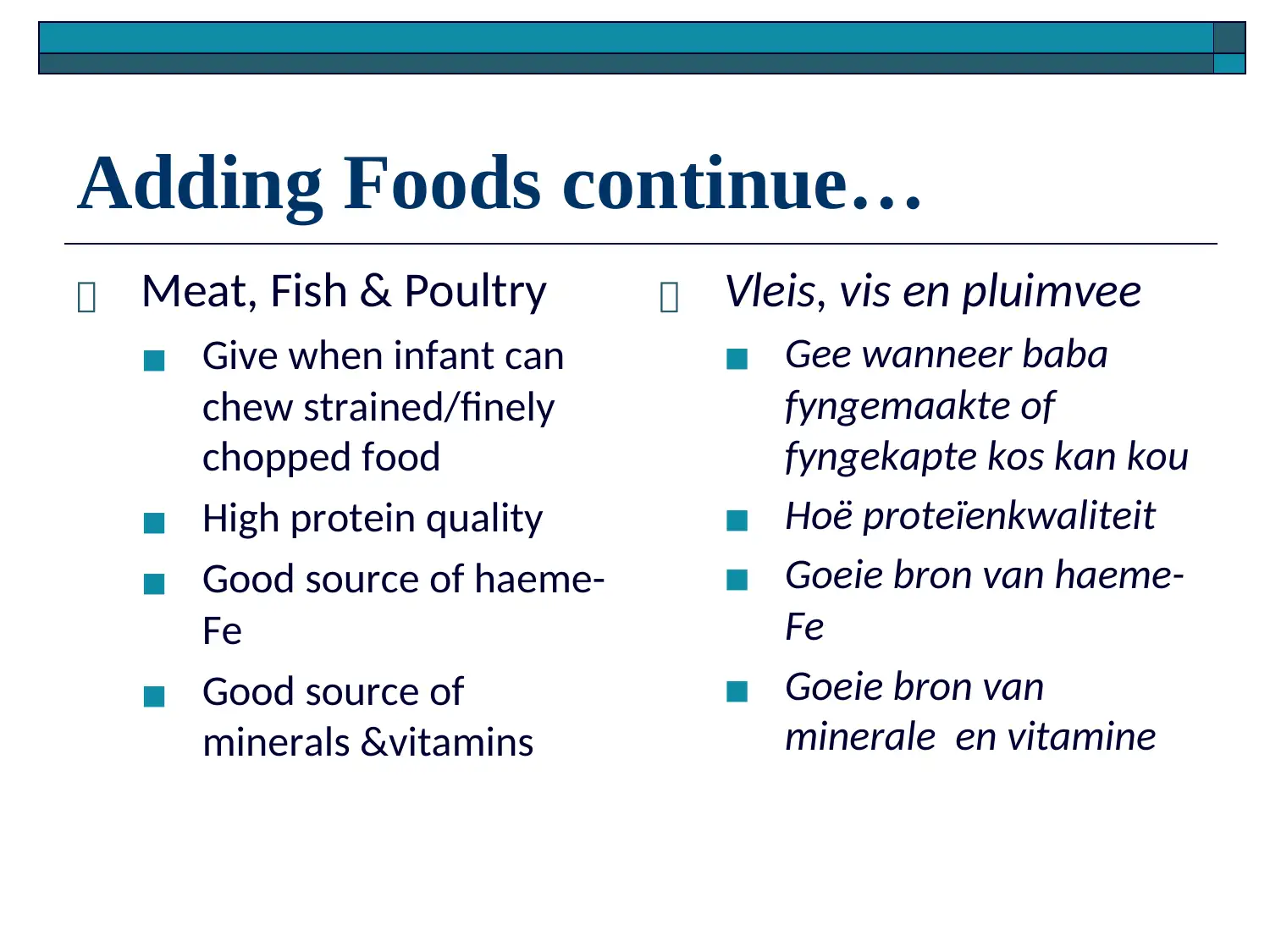
Adding Foods continue…
Meat, Fish & Poultry
◼ Give when infant can
chew strained/finely
chopped food
◼ High protein quality
◼ Good source of haeme-
Fe
◼ Good source of
minerals &vitamins
Vleis, vis en pluimvee
◼ Gee wanneer baba
fyngemaakte of
fyngekapte kos kan kou
◼ Hoë proteïenkwaliteit
◼ Goeie bron van haeme-
Fe
◼ Goeie bron van
minerale en vitamine
Meat, Fish & Poultry
◼ Give when infant can
chew strained/finely
chopped food
◼ High protein quality
◼ Good source of haeme-
Fe
◼ Good source of
minerals &vitamins
Vleis, vis en pluimvee
◼ Gee wanneer baba
fyngemaakte of
fyngekapte kos kan kou
◼ Hoë proteïenkwaliteit
◼ Goeie bron van haeme-
Fe
◼ Goeie bron van
minerale en vitamine
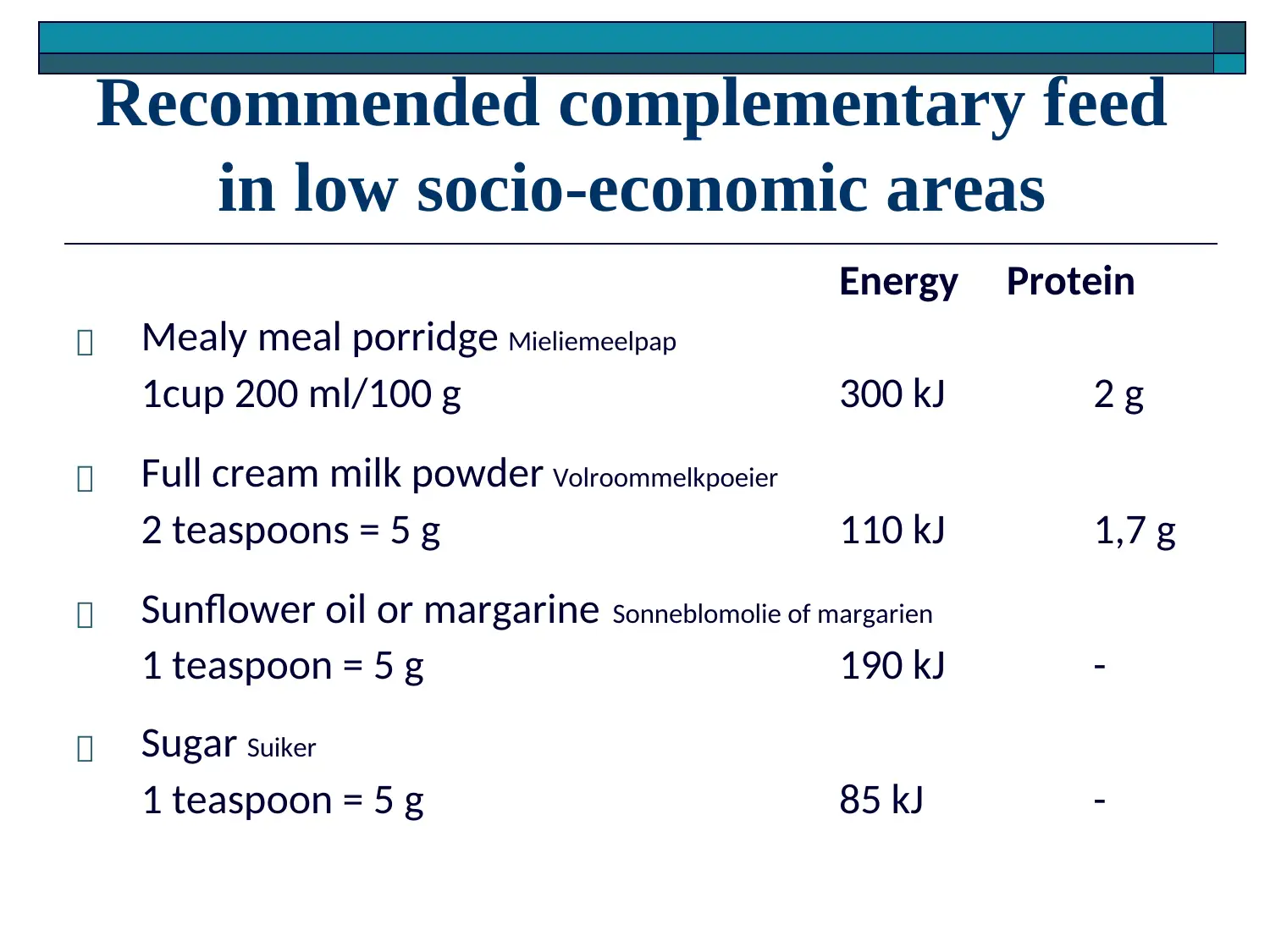
Recommended complementary feed
in low socio-economic areas
Energy Protein
Mealy meal porridge Mieliemeelpap
1cup 200 ml/100 g 300 kJ 2 g
Full cream milk powder Volroommelkpoeier
2 teaspoons = 5 g 110 kJ 1,7 g
Sunflower oil or margarine Sonneblomolie of margarien
1 teaspoon = 5 g 190 kJ -
Sugar Suiker
1 teaspoon = 5 g 85 kJ -
in low socio-economic areas
Energy Protein
Mealy meal porridge Mieliemeelpap
1cup 200 ml/100 g 300 kJ 2 g
Full cream milk powder Volroommelkpoeier
2 teaspoons = 5 g 110 kJ 1,7 g
Sunflower oil or margarine Sonneblomolie of margarien
1 teaspoon = 5 g 190 kJ -
Sugar Suiker
1 teaspoon = 5 g 85 kJ -
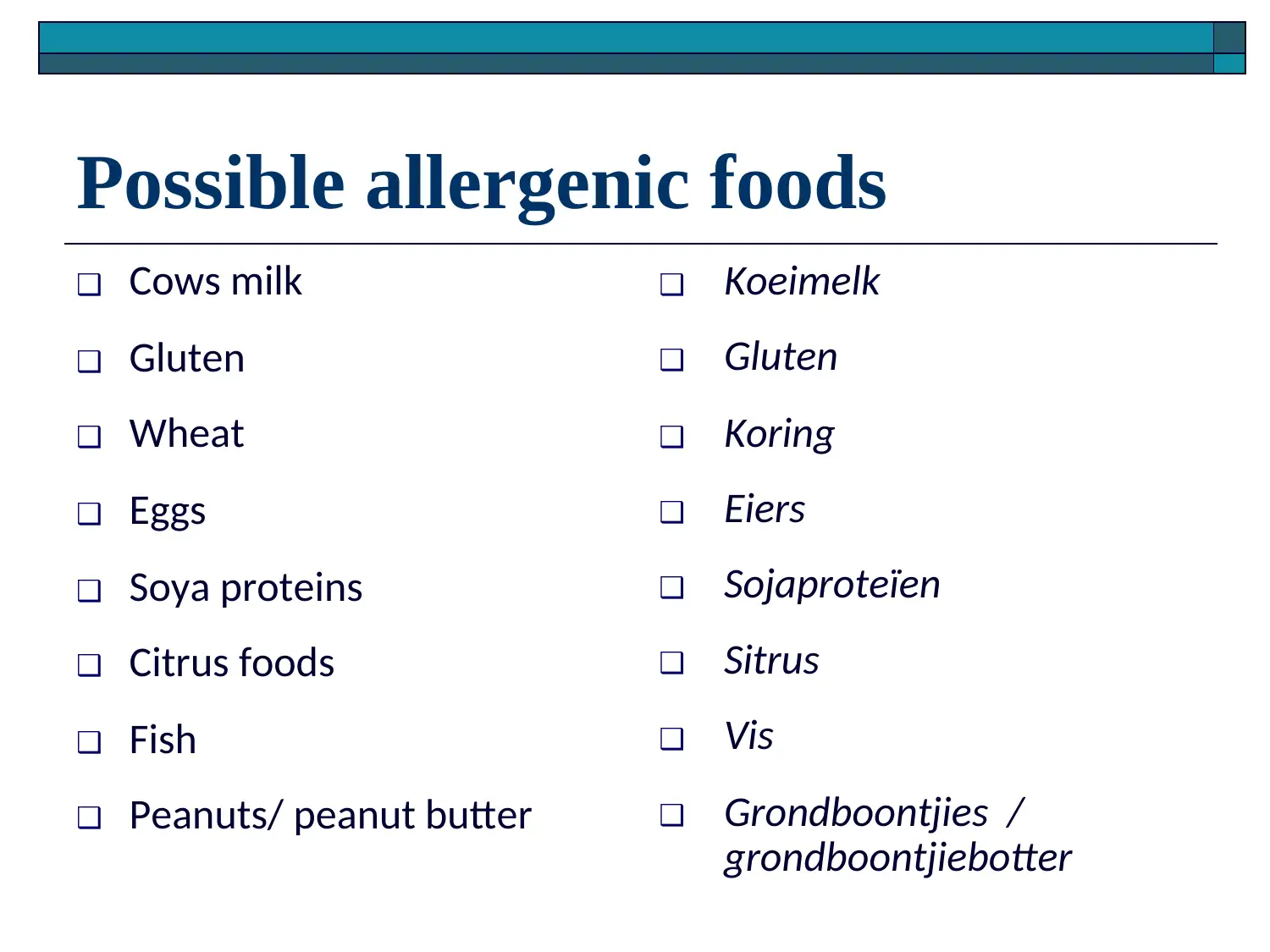
Possible allergenic foods
❑ Cows milk
❑ Gluten
❑ Wheat
❑ Eggs
❑ Soya proteins
❑ Citrus foods
❑ Fish
❑ Peanuts/ peanut butter
❑ Koeimelk
❑ Gluten
❑ Koring
❑ Eiers
❑ Sojaproteïen
❑ Sitrus
❑ Vis
❑ Grondboontjies /
grondboontjiebotter
❑ Cows milk
❑ Gluten
❑ Wheat
❑ Eggs
❑ Soya proteins
❑ Citrus foods
❑ Fish
❑ Peanuts/ peanut butter
❑ Koeimelk
❑ Gluten
❑ Koring
❑ Eiers
❑ Sojaproteïen
❑ Sitrus
❑ Vis
❑ Grondboontjies /
grondboontjiebotter
Paraphrase This Document
Need a fresh take? Get an instant paraphrase of this document with our AI Paraphraser
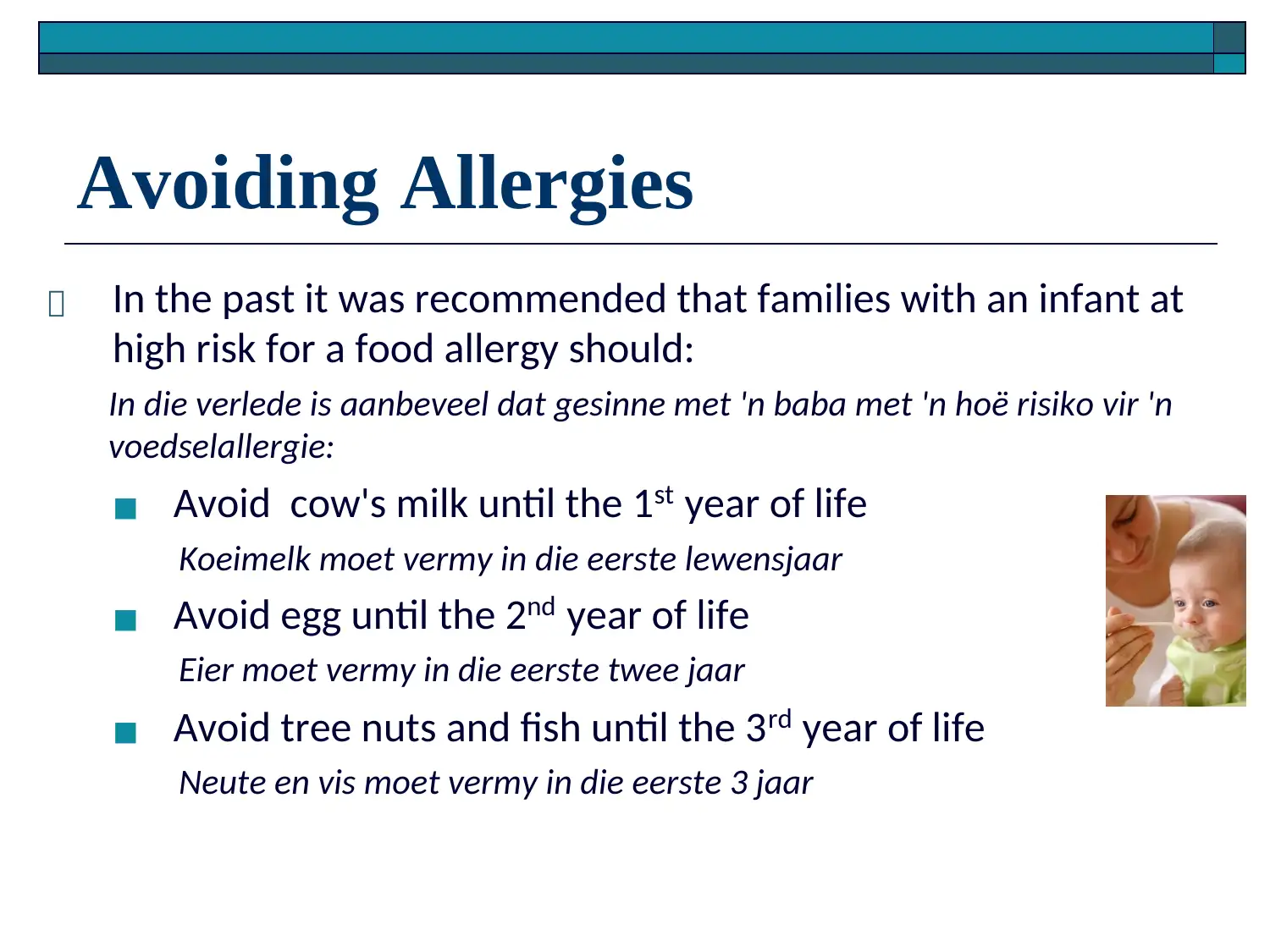
Avoiding Allergies
In the past it was recommended that families with an infant at
high risk for a food allergy should:
In die verlede is aanbeveel dat gesinne met 'n baba met 'n hoë risiko vir 'n
voedselallergie:
◼ Avoid cow's milk until the 1st year of life
Koeimelk moet vermy in die eerste lewensjaar
◼ Avoid egg until the 2nd year of life
Eier moet vermy in die eerste twee jaar
◼ Avoid tree nuts and fish until the 3rd year of life
Neute en vis moet vermy in die eerste 3 jaar
In the past it was recommended that families with an infant at
high risk for a food allergy should:
In die verlede is aanbeveel dat gesinne met 'n baba met 'n hoë risiko vir 'n
voedselallergie:
◼ Avoid cow's milk until the 1st year of life
Koeimelk moet vermy in die eerste lewensjaar
◼ Avoid egg until the 2nd year of life
Eier moet vermy in die eerste twee jaar
◼ Avoid tree nuts and fish until the 3rd year of life
Neute en vis moet vermy in die eerste 3 jaar
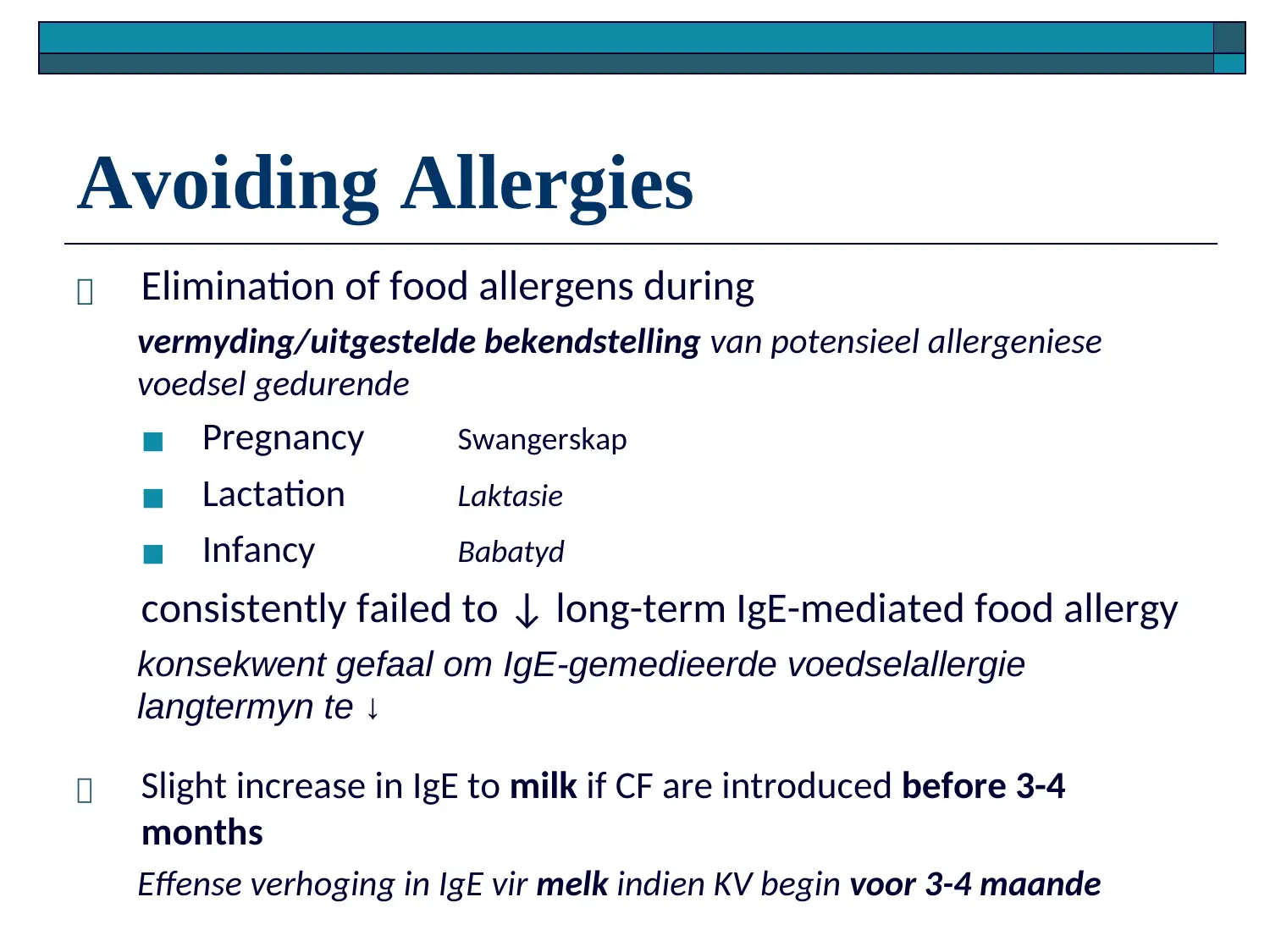
Avoiding Allergies
Elimination of food allergens during
vermyding/uitgestelde bekendstelling van potensieel allergeniese
voedsel gedurende
◼ Pregnancy Swangerskap
◼ Lactation Laktasie
◼ Infancy Babatyd
consistently failed to ↓ long-term IgE-mediated food allergy
konsekwent gefaal om IgE-gemedieerde voedselallergie
langtermyn te ↓
Slight increase in IgE to milk if CF are introduced before 3-4
months
Effense verhoging in IgE vir melk indien KV begin voor 3-4 maande
Elimination of food allergens during
vermyding/uitgestelde bekendstelling van potensieel allergeniese
voedsel gedurende
◼ Pregnancy Swangerskap
◼ Lactation Laktasie
◼ Infancy Babatyd
consistently failed to ↓ long-term IgE-mediated food allergy
konsekwent gefaal om IgE-gemedieerde voedselallergie
langtermyn te ↓
Slight increase in IgE to milk if CF are introduced before 3-4
months
Effense verhoging in IgE vir melk indien KV begin voor 3-4 maande
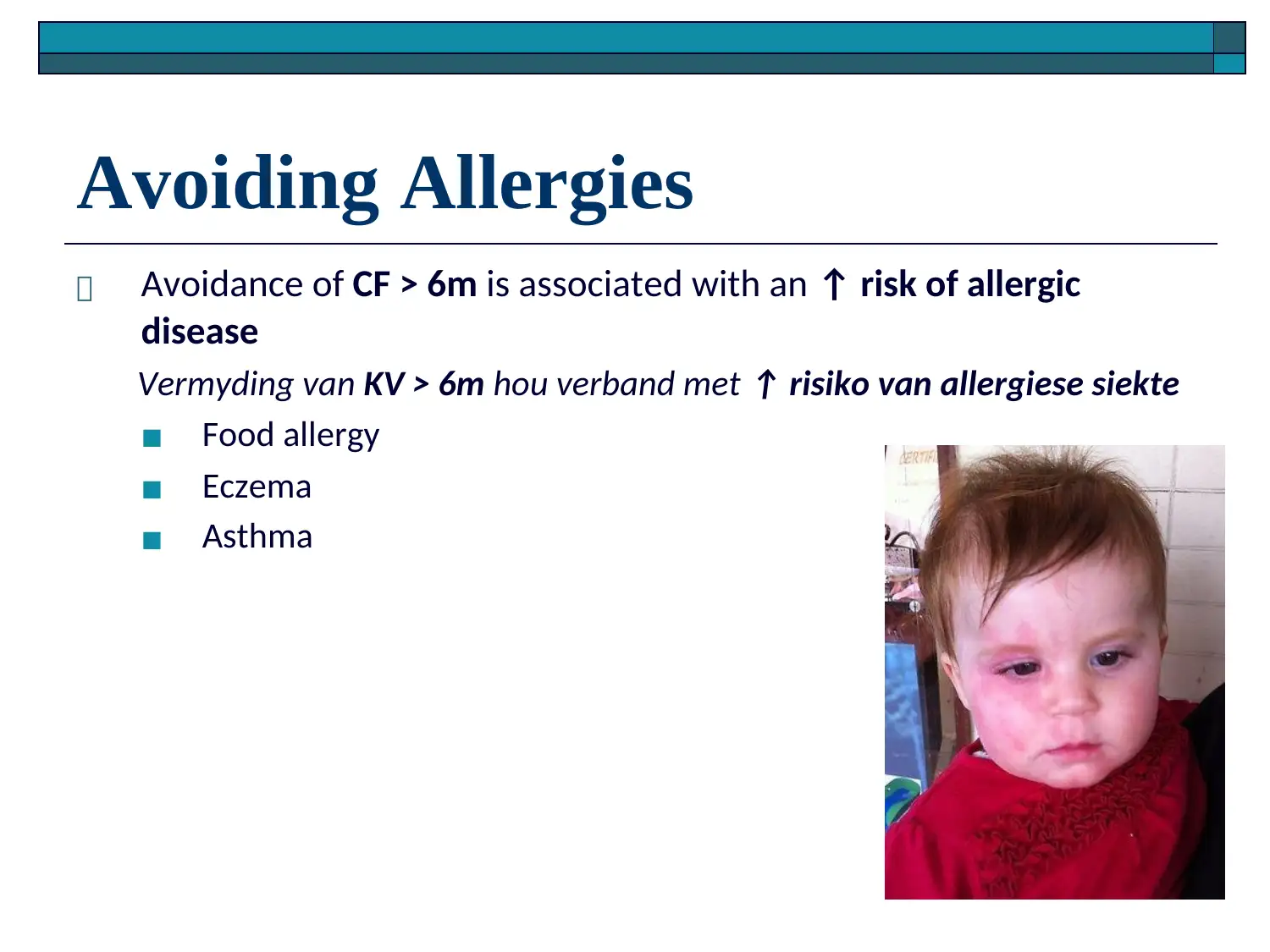
Avoiding Allergies
Avoidance of CF > 6m is associated with an ↑ risk of allergic
disease
Vermyding van KV > 6m hou verband met ↑ risiko van allergiese siekte
◼ Food allergy
◼ Eczema
◼ Asthma
Avoidance of CF > 6m is associated with an ↑ risk of allergic
disease
Vermyding van KV > 6m hou verband met ↑ risiko van allergiese siekte
◼ Food allergy
◼ Eczema
◼ Asthma
Secure Best Marks with AI Grader
Need help grading? Try our AI Grader for instant feedback on your assignments.
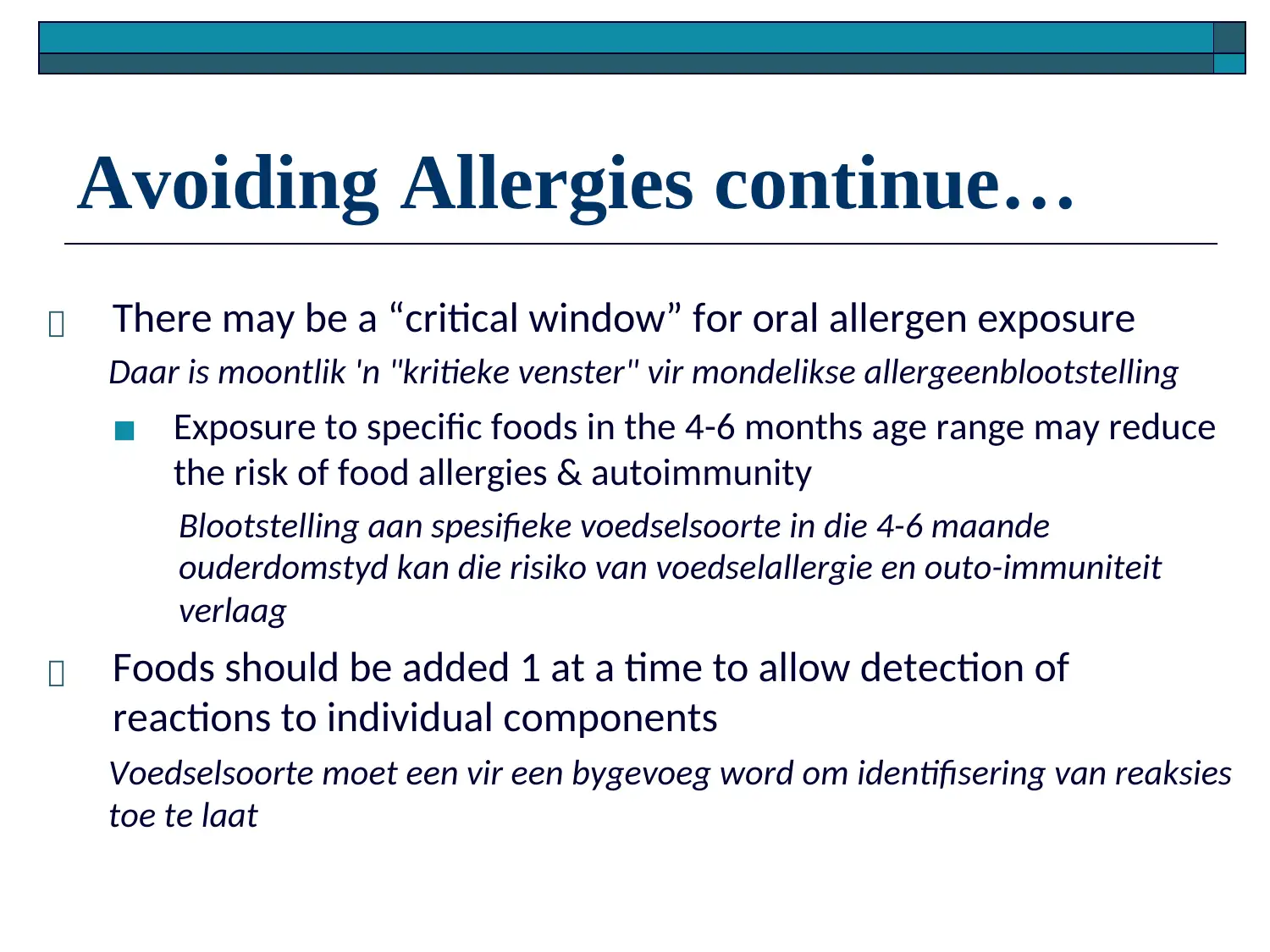
Avoiding Allergies continue…
There may be a “critical window” for oral allergen exposure
Daar is moontlik 'n "kritieke venster" vir mondelikse allergeenblootstelling
◼ Exposure to specific foods in the 4-6 months age range may reduce
the risk of food allergies & autoimmunity
Blootstelling aan spesifieke voedselsoorte in die 4-6 maande
ouderdomstyd kan die risiko van voedselallergie en outo-immuniteit
verlaag
Foods should be added 1 at a time to allow detection of
reactions to individual components
Voedselsoorte moet een vir een bygevoeg word om identifisering van reaksies
toe te laat
There may be a “critical window” for oral allergen exposure
Daar is moontlik 'n "kritieke venster" vir mondelikse allergeenblootstelling
◼ Exposure to specific foods in the 4-6 months age range may reduce
the risk of food allergies & autoimmunity
Blootstelling aan spesifieke voedselsoorte in die 4-6 maande
ouderdomstyd kan die risiko van voedselallergie en outo-immuniteit
verlaag
Foods should be added 1 at a time to allow detection of
reactions to individual components
Voedselsoorte moet een vir een bygevoeg word om identifisering van reaksies
toe te laat
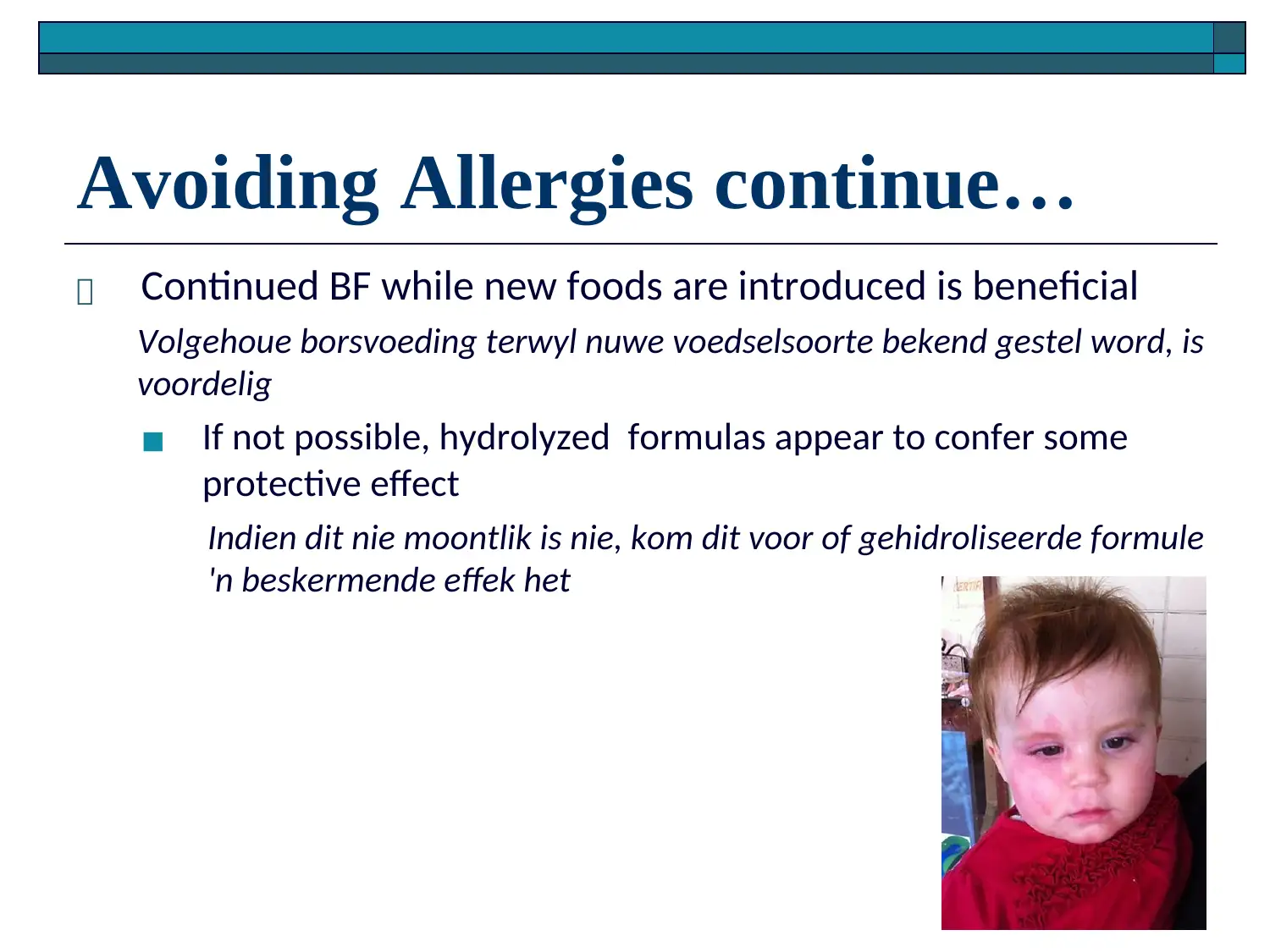
Avoiding Allergies continue…
Continued BF while new foods are introduced is beneficial
Volgehoue borsvoeding terwyl nuwe voedselsoorte bekend gestel word, is
voordelig
◼ If not possible, hydrolyzed formulas appear to confer some
protective effect
Indien dit nie moontlik is nie, kom dit voor of gehidroliseerde formule
'n beskermende effek het
Continued BF while new foods are introduced is beneficial
Volgehoue borsvoeding terwyl nuwe voedselsoorte bekend gestel word, is
voordelig
◼ If not possible, hydrolyzed formulas appear to confer some
protective effect
Indien dit nie moontlik is nie, kom dit voor of gehidroliseerde formule
'n beskermende effek het
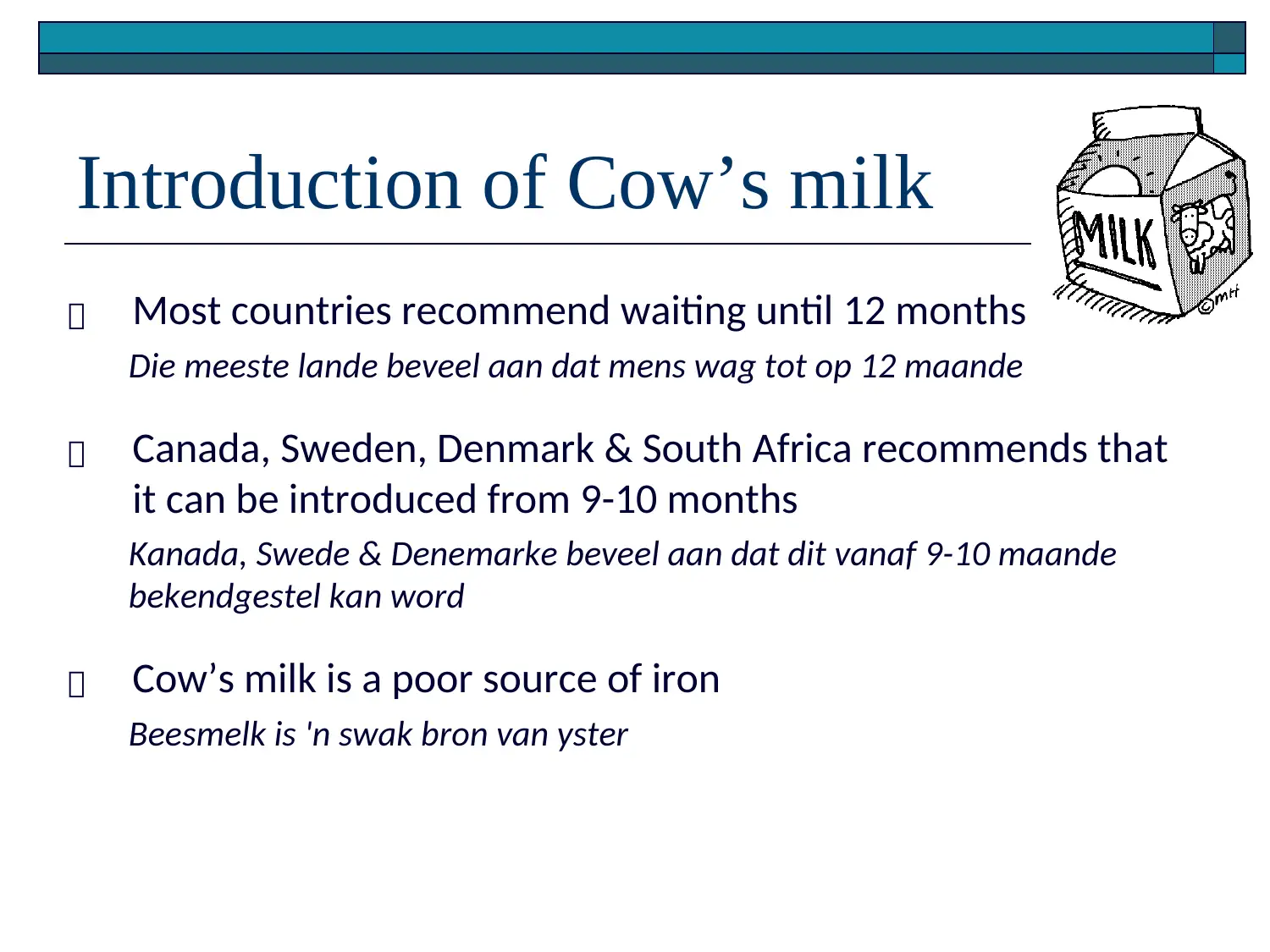
Introduction of Cow’s milk
Most countries recommend waiting until 12 months
Die meeste lande beveel aan dat mens wag tot op 12 maande
Canada, Sweden, Denmark & South Africa recommends that
it can be introduced from 9-10 months
Kanada, Swede & Denemarke beveel aan dat dit vanaf 9-10 maande
bekendgestel kan word
Cow’s milk is a poor source of iron
Beesmelk is 'n swak bron van yster
Most countries recommend waiting until 12 months
Die meeste lande beveel aan dat mens wag tot op 12 maande
Canada, Sweden, Denmark & South Africa recommends that
it can be introduced from 9-10 months
Kanada, Swede & Denemarke beveel aan dat dit vanaf 9-10 maande
bekendgestel kan word
Cow’s milk is a poor source of iron
Beesmelk is 'n swak bron van yster
Paraphrase This Document
Need a fresh take? Get an instant paraphrase of this document with our AI Paraphraser
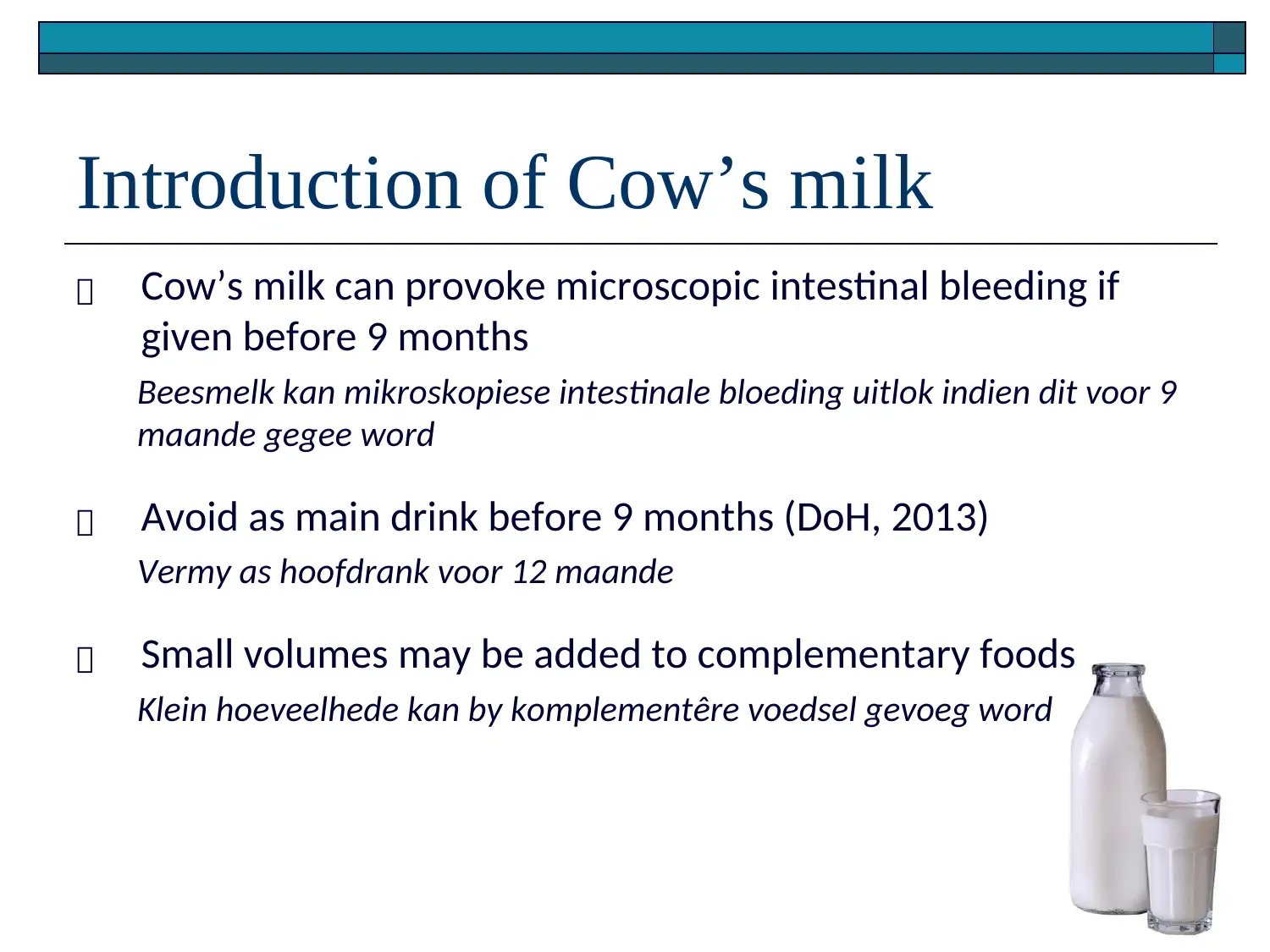
Introduction of Cow’s milk
Cow’s milk can provoke microscopic intestinal bleeding if
given before 9 months
Beesmelk kan mikroskopiese intestinale bloeding uitlok indien dit voor 9
maande gegee word
Avoid as main drink before 9 months (DoH, 2013)
Vermy as hoofdrank voor 12 maande
Small volumes may be added to complementary foods
Klein hoeveelhede kan by komplementêre voedsel gevoeg word
Cow’s milk can provoke microscopic intestinal bleeding if
given before 9 months
Beesmelk kan mikroskopiese intestinale bloeding uitlok indien dit voor 9
maande gegee word
Avoid as main drink before 9 months (DoH, 2013)
Vermy as hoofdrank voor 12 maande
Small volumes may be added to complementary foods
Klein hoeveelhede kan by komplementêre voedsel gevoeg word
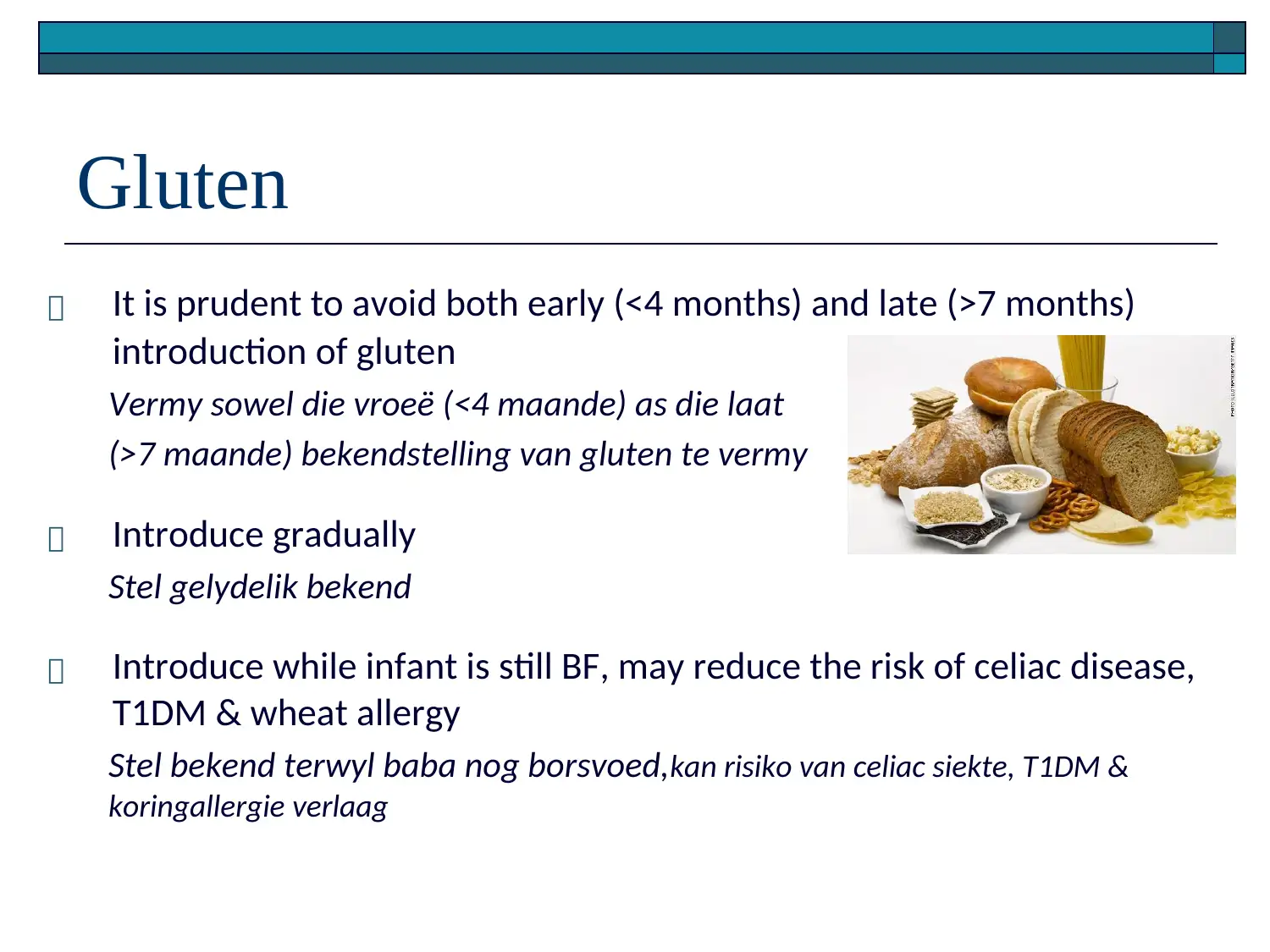
Gluten
It is prudent to avoid both early (<4 months) and late (>7 months)
introduction of gluten
Vermy sowel die vroeë (<4 maande) as die laat
(>7 maande) bekendstelling van gluten te vermy
Introduce gradually
Stel gelydelik bekend
Introduce while infant is still BF, may reduce the risk of celiac disease,
T1DM & wheat allergy
Stel bekend terwyl baba nog borsvoed,kan risiko van celiac siekte, T1DM &
koringallergie verlaag
It is prudent to avoid both early (<4 months) and late (>7 months)
introduction of gluten
Vermy sowel die vroeë (<4 maande) as die laat
(>7 maande) bekendstelling van gluten te vermy
Introduce gradually
Stel gelydelik bekend
Introduce while infant is still BF, may reduce the risk of celiac disease,
T1DM & wheat allergy
Stel bekend terwyl baba nog borsvoed,kan risiko van celiac siekte, T1DM &
koringallergie verlaag
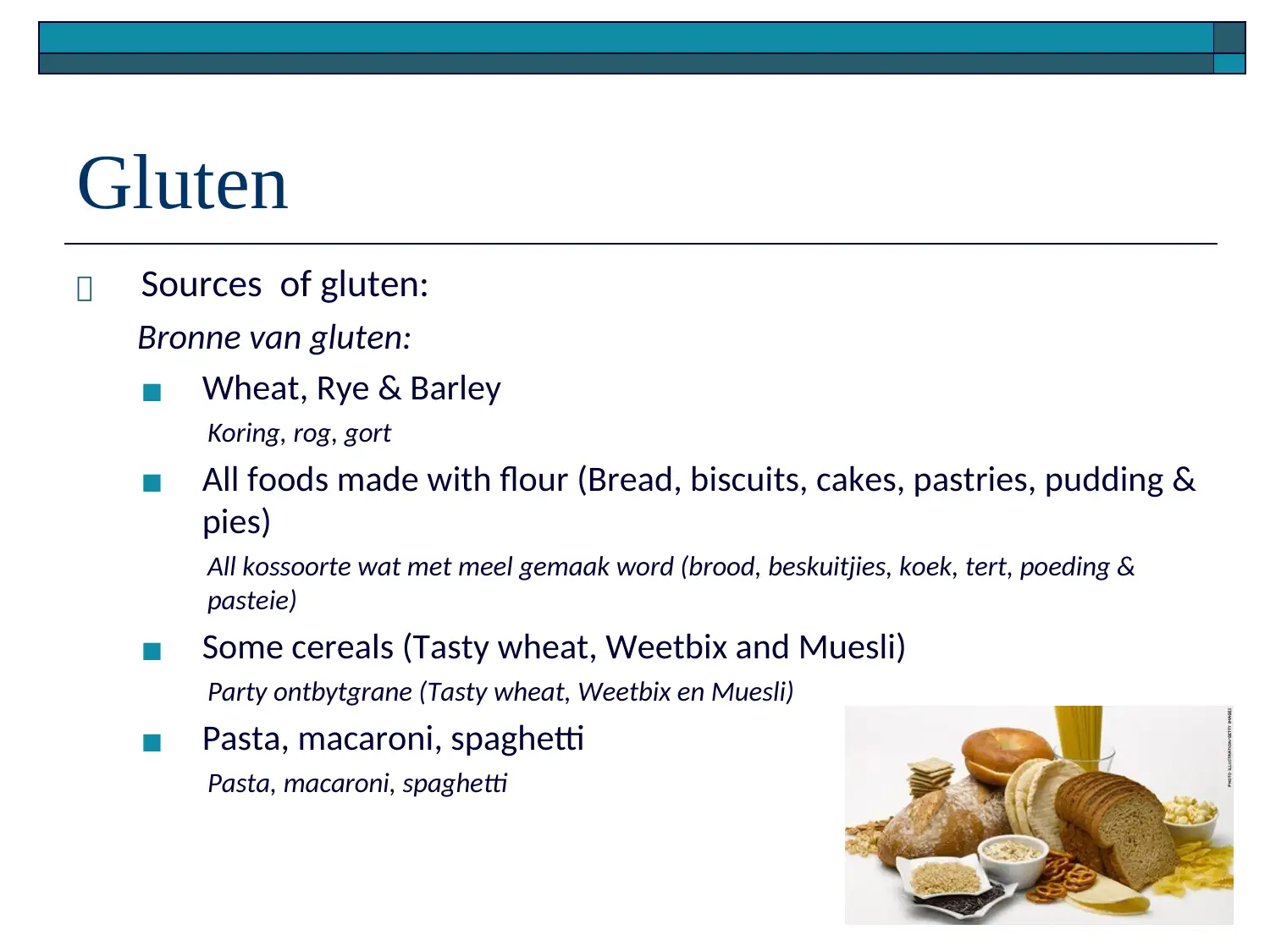
Gluten
Sources of gluten:
Bronne van gluten:
◼ Wheat, Rye & Barley
Koring, rog, gort
◼ All foods made with flour (Bread, biscuits, cakes, pastries, pudding &
pies)
All kossoorte wat met meel gemaak word (brood, beskuitjies, koek, tert, poeding &
pasteie)
◼ Some cereals (Tasty wheat, Weetbix and Muesli)
Party ontbytgrane (Tasty wheat, Weetbix en Muesli)
◼ Pasta, macaroni, spaghetti
Pasta, macaroni, spaghetti
Sources of gluten:
Bronne van gluten:
◼ Wheat, Rye & Barley
Koring, rog, gort
◼ All foods made with flour (Bread, biscuits, cakes, pastries, pudding &
pies)
All kossoorte wat met meel gemaak word (brood, beskuitjies, koek, tert, poeding &
pasteie)
◼ Some cereals (Tasty wheat, Weetbix and Muesli)
Party ontbytgrane (Tasty wheat, Weetbix en Muesli)
◼ Pasta, macaroni, spaghetti
Pasta, macaroni, spaghetti
Secure Best Marks with AI Grader
Need help grading? Try our AI Grader for instant feedback on your assignments.
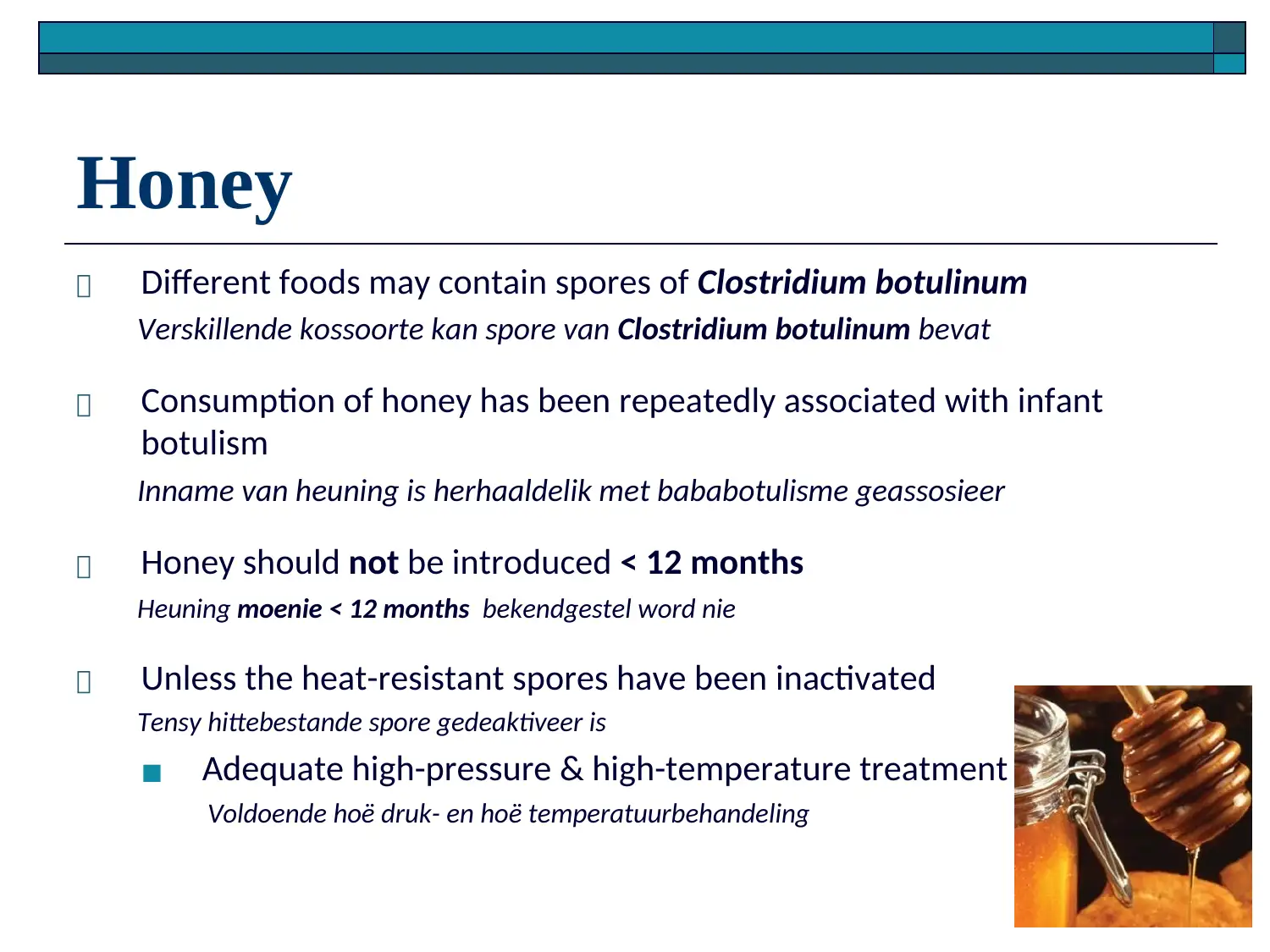
Honey
Different foods may contain spores of Clostridium botulinum
Verskillende kossoorte kan spore van Clostridium botulinum bevat
Consumption of honey has been repeatedly associated with infant
botulism
Inname van heuning is herhaaldelik met bababotulisme geassosieer
Honey should not be introduced < 12 months
Heuning moenie < 12 months bekendgestel word nie
Unless the heat-resistant spores have been inactivated
Tensy hittebestande spore gedeaktiveer is
◼ Adequate high-pressure & high-temperature treatment
Voldoende hoë druk- en hoë temperatuurbehandeling
Different foods may contain spores of Clostridium botulinum
Verskillende kossoorte kan spore van Clostridium botulinum bevat
Consumption of honey has been repeatedly associated with infant
botulism
Inname van heuning is herhaaldelik met bababotulisme geassosieer
Honey should not be introduced < 12 months
Heuning moenie < 12 months bekendgestel word nie
Unless the heat-resistant spores have been inactivated
Tensy hittebestande spore gedeaktiveer is
◼ Adequate high-pressure & high-temperature treatment
Voldoende hoë druk- en hoë temperatuurbehandeling
1 out of 35
Your All-in-One AI-Powered Toolkit for Academic Success.
+13062052269
info@desklib.com
Available 24*7 on WhatsApp / Email
![[object Object]](/_next/static/media/star-bottom.7253800d.svg)
Unlock your academic potential
© 2024 | Zucol Services PVT LTD | All rights reserved.